This is “The Victorian Era”, chapter 7 from the book British Literature Through History (v. 0.1). For details on it (including licensing), click here.
For more information on the source of this book, or why it is available for free, please see the project's home page. You can browse or download additional books there. To download a .zip file containing this book to use offline, simply click here.
Chapter 7 The Victorian Era
PLEASE NOTE: This book is currently in draft form; material is not final.
7.1 The Victorian Era (1832–1901)
PLEASE NOTE: This book is currently in draft form; material is not final.
Learning Objectives
- Recognize and evaluate the influence that Queen Victoria and Prince Albert exerted on the last half of the 19th century.
- Identify and explain the conflicts that defined the Victorian Era.
- Assess the ways in which these conflicts influenced Victorian literature.
- List, define, and give examples of typical forms of Victorian literature.

Snow Hill, Holburn, London (Anonymous).
“It was the best of times, it was the worst of times…”
Charles Dickens, A Tale of Two Cities
The Victorian Age—the era when the sun never set on the British Empire, a time when the upper classes of Britain felt their society was the epitome of prosperity, progress, and virtue—Dickens’s words, however, could apply to his own Victorian age as well as they apply to the French Revolution setting of his novel. The Victorian Era was a time of contrasts—poverty as well as prosperity, degrading manual labor as well as technological progress, and depravity as well as virtue.
Queen Victoria
The last seventy years of the 19th century were named for the long-reigning Queen Victoria. The beginning of the Victorian Era may be rounded off to 1830 although many scholars mark the beginning from the passage of the first Reform Bill in 1832 or Victoria’s accession to the throne in 1837.
Victoria was only eighteen when her uncle William IV died and, having no surviving legitimate children, left the crown to his niece.
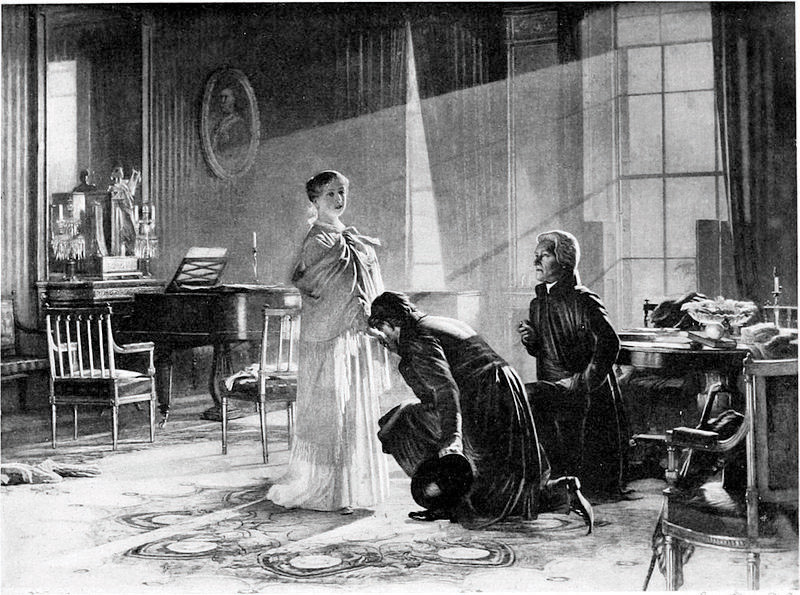
Victoria receives the news that she is Queen. Engraved by Emery Walker (1851–1933), from the picture by Henry Tanworth Wells (1828–1903) at Buckingham Palace.
Although by the 19th century Britain was a constitutional monarchy and the queen held little governing power, Victoria set the moral and political tone of her century. She became a symbol of decency, decorum, and duty.
Three years into her reign, Victoria married Albert of Saxe-Coburg-Gotha, a region in what is now Germany. Prince Albert (given the title “Prince” by Victoria), although he had no actual power in the government, became one of Victoria’s chief advisors and a proponent of technological development in Britain. Together the couple had nine children who married into many of Europe’s royal and noble families. Victoria and Albert were considered the model of morality and respectable family life.
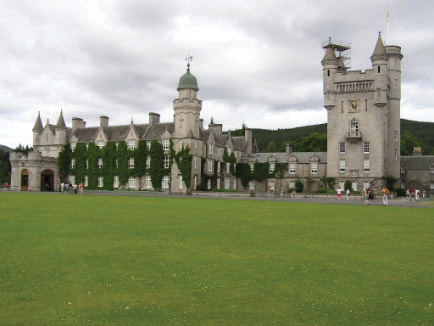
Balmoral Castle, the royal residence in Scotland.
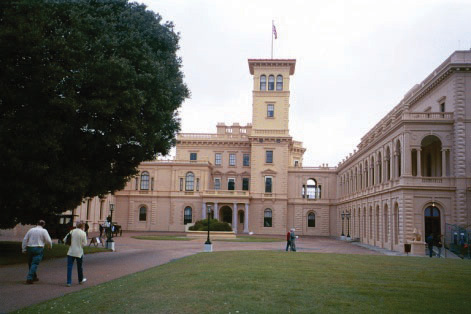
Osborne House, the royal residence on the Isle of Wight.
When Prince Albert died in 1861, Victoria retired from public view, spending time in her Balmoral Castle in Scotland or Osborne House on the Isle of Wight. Public opinion of the queen waned as years passed without her resuming her official duties. Even when she conceded to her advisors’ urging to return to London and to honor her public obligations, she continued to wear mourning until her own death. She also commissioned many public memorials to Prince Albert, including the Albert Memorial in Hyde Park (near the original location of the Crystal Palace), Royal Albert Hall, and the Victoria & Albert Museum.
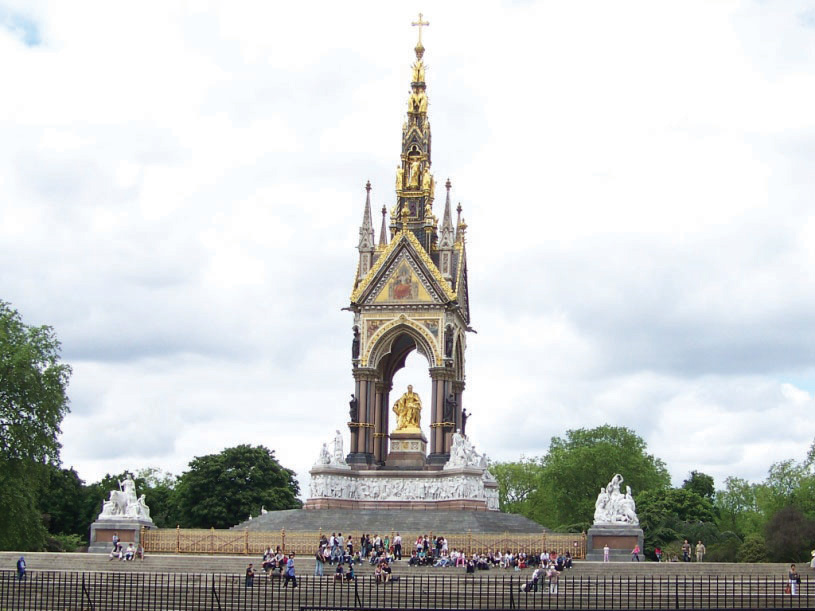
The Albert Memorial, Hyde Park, London.

Royal Albert Hall, London.
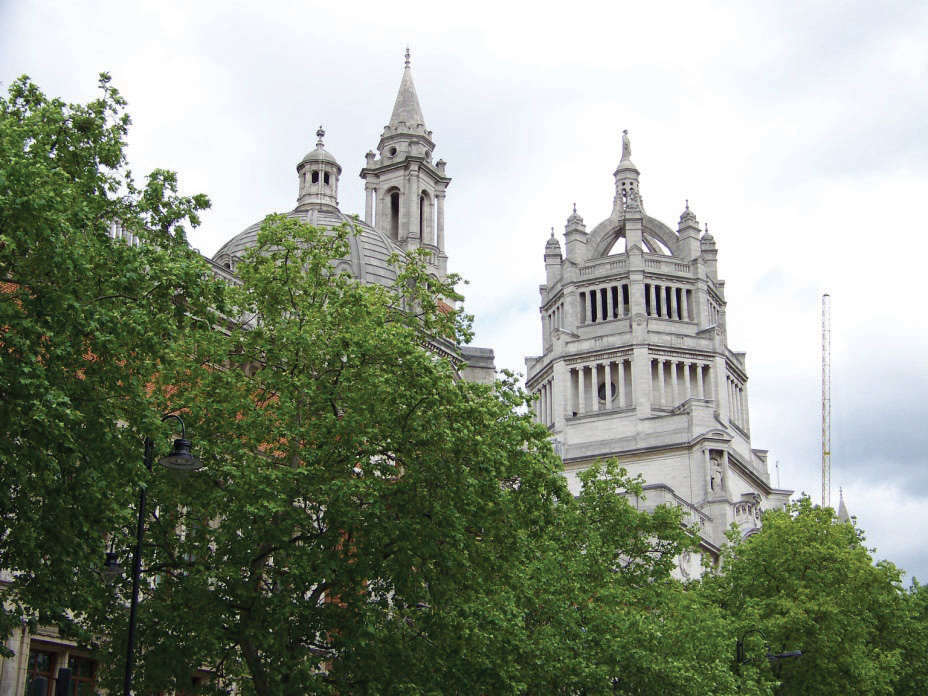
The ornamental dome on the Victoria & Albert Museum was modeled after Queen Victoria’s favorite crown, visible in the portrait below, now on display with the Crown Jewels at the Tower of London.
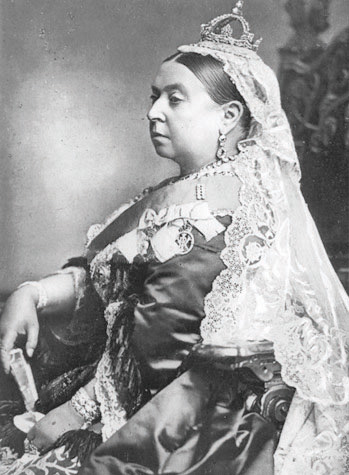
Photograph by Alexander Bassano 1829–1913.
Queen Victoria reigned as Queen of the United Kingdom and Empress of India until her death in 1901.
Victorian Conflicts
The Victorian Era was, in many ways, paradoxically “the best times” and “the worst of times.”
Conflicts of Morality
Queen Victoria embodied ideals of virtue, modesty, and honor. In fact, the term Victorian has in the past been almost a synonym for prim, prudish behavior. At the same time, London and other British cities had countless gaming halls which provided venues not just for gambling but also opium dens and prostitution. With the influx of population into the cities, desperate working class women turned to prostitution in attempts to support themselves and their children. Historian Judity Walkowitz reports that 19th century cities had 1 prostitute for every 12 adult males (quoted in “The Great Social Evil”: Victorian Prostitution by Prof. Christine Roth). Because of rampant sexually transmitted diseases among the British military, Parliament passed a series of Contagious Diseases Acts in the 1860s. These acts allowed police to detain any woman suspected of having a sexually transmitted disease and to force her to submit to exams that were considered humiliating for women at that time. Police needed little basis for such suspicions, often simply that a woman was poor.
Thomas Hardy’s poem “The Ruined Maid” reveals one reason many women turned to prostitution (ruined is a Victorian euphemism for an unmarried woman who has lost her virginity): in the poem, two young women converse. One woman, Melia, has left the farm to become a prostitute. When she meets a former friend, the contrast between the two women is pronounced: Melia is wearing fine clothes and is well fed and well cared for. The virtuous young woman, doing honest work on the farm, is wearing rags, digging potatoes by hand for subsistence, and suffering poor health. Hardy forces his readers to question what kind of society would reward prostitution while leaving the virtuous woman in abject poverty.
Conflicts of Technology and Industry
As an advocate of Victorian progress in science and industry, Prince Albert commissioned the Great Exhibition of 1851, a type of world’s fair where all the countries in the British Empire had displays and Britain could show off its prosperity to the rest of the world. Albert had the Crystal Palace, a huge, modern building of glass and iron, built in Hyde Park to house the exhibition. After the Great Exhibition ended, the building was dismantled and moved and in its new location was destroyed by fire in 1936.
Video Clip 1
The Albert Memorial Symbol of the Victorian Age
(click to see video)View a video lecture about the Albert Memorial.
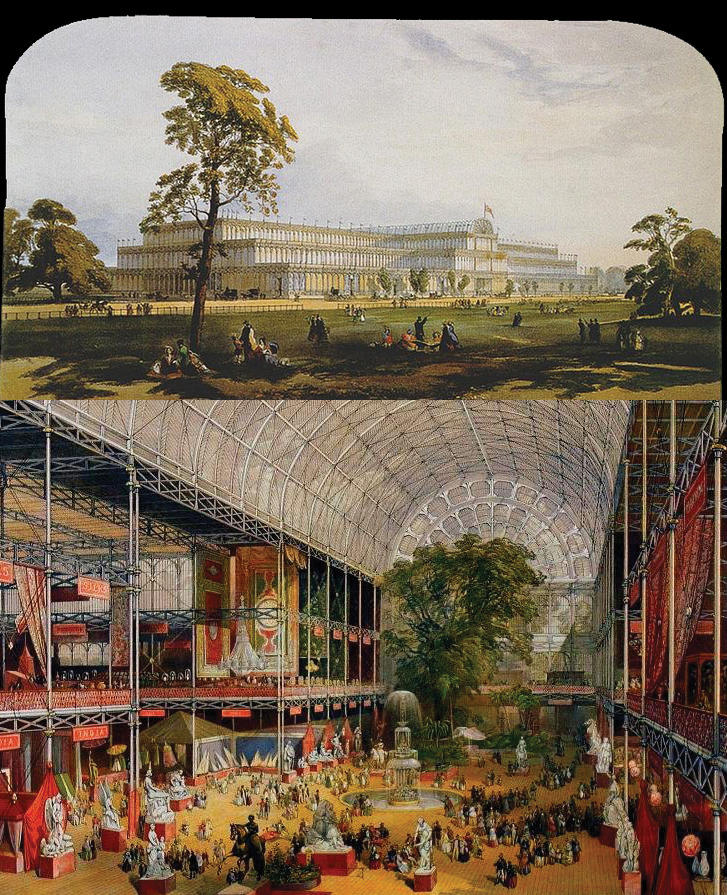
The Great Exhibition of 1851 held in the Crystal Palace, Hyde Park, London.
Source: Exterior: from Dickinson's Comprehensive Pictures of the Great Exhibition of 1851, 1854 interior: William Simpson (lithographer), Ackermann & Co. (publisher), 1851, V&A.
The Albert Memorial commemorated all the same things the Great Exhibition vaunted. The four arms extending from the main statue represent four continents on which the British Empire had holdings: Europe, Asia, Africa, and the Americas—the sun literally never set on the British Empire. The figures on the frieze are great painters, poets, sculptors, musicians, and architects, representatives of the world’s accomplishments which culminated in the British Victorian culture. The mosaics on the canopy represent manufacturing, commerce, agriculture, and engineering—the foundations of British prosperity. And, of course, in the center, is the gilded figure of Albert himself.
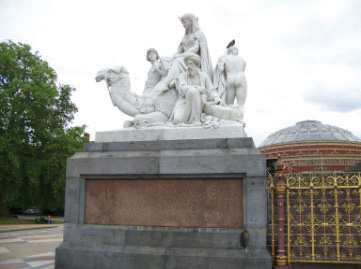
Arm representing Africa.

Prince Albert’s Great Exhibition of 1851 focused attention on the technological advances made during the Industrial Revolution. Although achievements such as the building of the railroad system and the implementation of mechanized factories produced great prosperity for some, others suffered. Even before the Victorian Era, writers drew attention to these problems. Wordsworth’s “Michael,” for example, portrays a man whose family had made their living from their land for many generations. With the advent of machines to weave woolen cloth, their livelihood, their way of life, was lost. Blake’s “Chimney Sweeper” poems illustrate how children suffered in the industrial age.
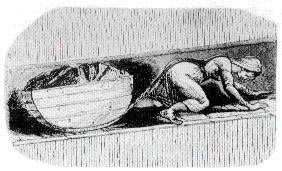
A girl pulling a coal tub in a mine.
Source: Parliamentary Papers 1842.
In addition, working conditions in factories were deplorable. With no safety regulations and no laws limiting either the number of hours people could be required to work or the age of factory workers, some factory owners were willing to sacrifice the well-being of their employees for greater profit. Children as young as five worked in factories and mines. Shelley’s “Men of England” and Barrett Browning’s “The Cry of the Children” are two examples of poems written specifically to address these problems.
The 1833 Factory Act outlawed the employment of people under age eighteen at night, from 8:30 p.m. to 5:30 a.m. and limited the number of hours those under eighteen could work to twelve hours a day. For the first time, textile factory owners were forbidden to employ children under the age of nine. Children under age eleven could not work more than nine hours a day. The 1833 Factory Act also stipulated that children working in factories attend some type of school.
The Mines Act of 1842 prohibited females and boys under ten from working below ground in mines.
While these provisions hardly seem protective according to modern standards, the resulting conditions greatly improved life for many children. Throughout Victoria’s reign, other parliamentary acts continued to alleviate working conditions in the ever-expanding Victorian industrial age.
Conflicts of Faith and Doubt
The scientific and technological advances celebrated at the Great Exhibition of 1851 led to another crisis in Victorian England: a crisis of faith and doubt. During the earlier part of the 19th century, the work of Charles Lyell and other geologists with their discoveries of fossilized remains of animals never seen before led to debates among scientists about the origins of these creatures. Debates about the age of the earth for some called into question the Genesis account of creation. In 1859, Charles Darwin published his On the Origin of Species. Lyell and Darwin were among many who contributed to scientific theories that some saw as contradictory to established religious beliefs.
These scientific issues together with apparent lack of concern for appalling human conditions among the lower classes led some to doubt the presence of a divine being in the world and others to question the value of Christianity. Literature by writers such as Thomas Hardy and Matthew Arnold questions the presence of religious faith in the world.
At the same time, a conviction that Britain had a duty to spread Christianity around the world became one reason, or to some an excuse, for British imperialism.
Conflicts over Imperialism
A desire to expand industrial wealth and to have access to inexpensive raw materials led to the British occupation of countries around the globe. Although the United States and other European countries participated in this type of imperialism, the British Empire was the largest and wealthiest of its time.
Along with their desire for material gain, many British saw the expansion of the British Empire as what Rudyard Kipling referred to as “the white man’s burden,” the responsibility of the British to bring their civilization and their way of life to what many considered inferior cultures. The result of this type of reasoning was often the destruction of local cultures and the oppression of local populations. In addition, a religious zeal to bring British religion to “heathen” peoples resulted in an influx of missionaries with the colonialists.
A backlash of protest against the concept of imperialism further divided a British nation already divided by class, religion, education, and wealth. While many British citizens sincerely desired to share their knowledge and beliefs with less developed nations, others found the movement a convenient excuse to expand their country’s, and their own, power and wealth.
Conflicts over Women’s Rights
“The Queen is most anxious to enlist everyone who can speak or write to join in checking this mad, wicked folly of ‘Woman’s Rights,’ with all its attendant horrors, on which her poor feeble sex is bent, forgetting every sense of womanly feeling and propriety.”Queen Victoria, 1870
quoted in Lytton Strachey’s Queen Victoria)
Ironically, as seen in this passage from a letter written in the royal third person by Queen Victoria, even the Queen opposed women’s rights. Nonetheless, the Victorian Era did see advancement in women’s political rights. The Married Woman’s Property Act of 1870 gave married women the right to own property they earned or acquired by inheritance. The upper classes were, of course, primarily concerned with inheritances. Before the passage of this act, money or property left to a married woman immediately belonged to her husband. By the late 19th century, women had some rights to their children and the right to leave their husbands because of physical abuse.
Education for women also improved. The idea Mary Wollstonecraft expressed in her “A Vindication of the Rights of Woman” in 1792 very gradually, over more than 100 years, became a reality.
The first schools for the lower classes, girls or boys, were Sunday schools organized by churches to teach children basic literacy as well as religious lessons on the only day they were not working full time. Not until the Education Act of 1870 were public schools in all areas of the country provided by law. Even then, attendance was not made compulsory for another ten years and then only for children aged five to ten.

A 19th century Sunday school.
Girls from the lower classes were included in the first public schools; however, girls from the upper classes continued to receive their basic education primarily in the home and in finishing schools for young ladies. Cambridge University and Oxford University established the first colleges for women in the latter half of the 19th century. Women were not allowed to attend the existing colleges for men and were not considered full members of the universities until the 20th century.
Although there was an active woman’s suffrage movement during the Victorian Era, women did not receive the right to vote until the 20th century.
Take the Women’s Rights Quiz on the BBC website to see how much you know about the rights of Victorian women.
Language
The major change in the English language during the 19th century was the introduction of vocabulary to communicate new innovations, inventions, and concepts that resulted from the Industrial Age. Language mirrored class distinctions in both vocabulary and accents. The well educated upper classes were distinguished by their speech. Slang and an entirely differently accented English were the marks of the lower classes.
Forms of Literature
Novel
As noted in the Romantic Period introduction, a novelAs defined in the Holman/Harmon Handbook to Literature, an “extended fictional prose narrative.”, as defined in the Holman/Harmon Handbook to Literature, is an “extended fictional prose narrative.” The novel was a dominant form in the Victorian Era. Many Victorian novelists—Charles Dickens, William Thackeray, Wilke Collins, George Eliot, Robert Louis Stevenson—wrote serial novelsNovels published in installments over a period of time., novels published in installments over a period of time. Serial novels appeared in newspapers or magazines or could be published in independently printed booklets. As larger portions of the population became literate, demand for reading material grew. The inexpensive booklets, each containing a chapter or other small portion of a novel, were affordable entertainment for the middle classes.
Poetry
As in the Romantic Period, lyric poetry was popular in the Victorian Era. In addition to the lyric, the verse novelA long narrative poem., a long narrative poem, such as Barrett Browning’s Aurora Leigh, Tennyson’s Idylls of the King, and Browning’s The Ring and the Book, also was a prevalent form. Browning popularized the dramatic monologueA form of poetry which presents a speaker in a dramatic situation., a form of poetry which presents a speaker in a dramatic situation.
Non-Fiction Prose
The many conflicts of the Victorian Era provided fertile subject matter for non-fiction prose writers such as Matthew Arnold, Thomas Carlyle, John Stuart Mill, John Henry Newman, Walter Pater, and John Ruskin.
Drama
Popular forms of entertainment such as the music hall and melodramas flourished during the Victorian Era as entertainment became divided along class lines. Popular music and musical plays, separated from legitimate theater in their own venues, provided leisure-time amusement for the middle classes. Robert Browning wrote closet dramasPlays not actually intended for the stage., plays not actually intended for the stage. Oscar Wilde revived the comedy of manners with plays such as Lady Windermere’s Fan and The Importance of Being Earnest.
Key Takeaways
- Although Queen Victoria symbolized decency, decorum, and duty, Victorian society spanned a wide spectrum of prosperity and poverty, education and ignorance, progress and regression
- Victorian society wrestled with conflicts of morality, technology and industry, faith and doubt, imperialism, and rights of women and ethnic minorities.
- Many Victorian writers addressed both sides of these conflicts in many forms of literature.
- Typical forms of Victorian literature include novels, serialized novels, lyric poetry, verse novels, dramatic monologues, non-fiction prose, and drama.
Resources
Victorianism
- “All Change in the Victorian Age.” Bruce Robinson. Britain’s Industrial Revolution. Victorians. BBC History.
- “Monuments and Dust: The Culture of Victorian London.” Michael Levenson, University of Virginia; David Trotter, University College London; Anthony Wohl, Vassar College. Institute for Advance Technology in the Humanities, University of Virginia; Department of English University College London; Cambridge University Press.
- “Movements and Currents in Nineteenth-Century British Thought.” The Victorian Web. George P. Landow, Brown University.
- “Overview of the Victorian Era.” History in Focus. Anne Shepherd. University of London.
- “Victorian and Victorianism.” The Victorian Web. George P. Landow, Brown University.
- “Victorian Britain.” History Trails. BBC.
- “Victorian England: An Introduction.” Christine Roth, University of Wisconsin, Oshkosh.
- “The Victorian Period.” Dr. Robert M. Kirschen, University of Nevada, Las Vegas.
- “Victorians 1837–1901.” Liza Picard. The British Library.
- “Victorians 1850–1901.” The National Archives.
Queen Victoria
- “Queen Victoria.” The Victorian Web. David Cody, Hartwick College.
Victorian Conflicts
Conflicts of Morality
- “Addiction in the Nineteenth Century.” Dr. Susan Zieger, Stanford University.
- “The Contagious Diseases Act.” The Victorian Web.
- “The Great Social Evil”: Victorian Prostitution. Prof. Christine Roth, University of Wisconsin, Oshkosh.
- “Opium Dens and Opium Usage in Victorian England.” Victorian History. Bruce Rosen, University of Tasmania.
Conflicts of Technology and Industry
- “1832 Reform Act.” Taking Liberties: The Struggle for Britain’s Freedoms and Rights. The British Library.
- “The 1833 Factory Act [from Statutes of the Realm, 3 & 4 William IV, c. 103].” The Victorian Web. Dr. Marjie Bloy, National University of Singapore.
- “19th Century Poor Law Union and Workhouse Records.” The National Archives. brief explanation of 1834 Poor Law and images.
- “Child Labor.” The Victorian Web. David Cody, Hartwick College.
- “Corn Laws.” The Victorian Web. David Cody, Hartwick College.
- “The Crystal Palace Animation.” The Institute for Advanced Technology in the Humanities. University of Virginia.
- “The Crystal Palace, or The Great Exhibition of 1851: An Overview.” The Victorian Web.
- “Great Exhibition.” Treasures. The National Archives.
- “The Great Exhibition.” History, Periods & Styles Features. The Victoria & Albert Museum.
- “The Great Exhibition at the Crystal Palace.” Victoria Station.
- “The Life of the Industrial Worker in Nineteenth-Century England.” The Victorian Web. Laura Del Col, West Virginia University.
- “The Reform Acts.” The Victorian Web. Glenn Everett, University of Tennessee at Martin.
- “Testimony Gathered by Ashley’s Mines Commission.” The Victorian Web. Laura Del Col, West Virginia University.
Conflicts of Faith and Doubt
- “Victorian Science & Religion.” The Victorian Web. Aileen Fyfe, National University of Ireland Galway and John van Wyhe, Cambridge University.
Conflict over Imperialism
- “The British Empire.” The Victorian Web. David Cody, Hartwick College.
- “British Empire.” The National Archives.
- “Kipling’s Imperialism.” The Victorian Web. David Cody, Hartwick College.
Conflicts over Women’s Rights
- “The 1870 Education Act.” Living Heritage: Going to School. www.parliament.uk.
- “Gender Ideology & Separate Spheres.” Gender, Health, Medicine & Sexuality in Victorian England. Victoria & Albert Museum.
- “Gender Matters.” The Victorian Web.
- “The National Union of Women’s Suffrage Societies.” The Victorian Web. Helena Wojtczak.
- “‘The Personal is Political’: Gender in Private & Public Life.” Gender, Health, Medicine & Sexuality in Victorian England. Victoria & Albert Museum.
- “The Suffragettes in Parliament.” History of Parliament Podcasts. www.parliament.uk.
- “Suffragists.” Learning: Dreamers and Dissenters. The British Library.
- “Victorian Britain: A Divided Nation?” Education. The National Archives.
- “Women’s Status in Mid 19th-Century England: A Brief Overview.” Helena Wojtczak. Hastings Press.
- “Women’s Rights Quiz.” Major Events of Victoria’s Reign. Victorians. BBC History.
- “Women’s Work.” Prof. Pat Hudson, Cardiff University. Daily Life in Victorian Britain. Victorians. BBC History.
Victorian Language
- “The Development of the English Language Following the Industrial Revolution.” The Victorian Web. Jessica Courtney, University of Brighton (UK).
Literature
- “The 19th Century Novel.” Novels. Dr. Agatha Taormina, Extended Learning Institute of Northern Virginia Community College.
- “Gerard Manley Hopkins and the Difficulties of Victorian Poetry.” The Victorian Web. George P. Landow, Brown University.
- “Justifying God’s Ways to Man (and Woman): The Victorian Long Poem.” The Victorian Web. George P. Landow. Brown University.
- “Literary Genre, Mode, and Style.” The Victorian Web.
- “Nineteenth Century Drama.” Theatre Database.
- “Progress of Journalism in the Victorian Era.” Bartleby.com. The Growth of Journalism. rpt. from The Cambridge History of English and American Literature in 18 Volumes (1907–21). Vol. XIV. The Victorian Age, Part Two.
- “Serial Publication.” Prof. Joel J. Brattin, Worcester Polytechnic Institute. Dickens. Life and Career. PBS.org.
- Some Questions to Use in Analyzing Novels. Prof. Stephen C. Behrendt, University of Nebraska, Lincoln.
- “Studies of Victorian Literature.” Dr. John P. Farrell, University of Texas at Austin.
- “Victorian Literature and Culture.” Prof. James Buzard. MIT Open Courseware.
- “Victorian Serial Novels.” Digital Collections. University of Victoria Libraries.
- “Victorian Women Writers Project.” University of Indiana Digital Library Project.
- “Why Read the Serial Versions of Victorian Novels?” The Victorian Web. Philip V. Allingham, Lakehead University.
Video
- “The Albert Memorial: Symbol of the Victorian Age.” Dr. Carol Lowe, McLennan Community College.
- “The Great Exhibition.” Victorians. The British Library.
- “The Rise of Technology and Industry.” Learning: Victorians. The British Library. images, slide shows, video, podcasts featuring all types of industry and technological advances in daily life, such as cooking and bathrooms.
Audio
- “A Visitor’s Guide to the Great Exhibition, from ‘The Illustrated Exhibitor.’” The Great Exhibition. Victorians. The British Library.
7.2 Charles Dickens (1812–1870)
PLEASE NOTE: This book is currently in draft form; material is not final.
Learning Objectives
- Recognize A Tale of Two Cities as a serial novel, and account for the popularity of serial novels in Victorian England.
- Evaluate the role of the novel’s structure in conveying themes.
- Define and illustrate the use of literary devices such as anaphora, asyndeton, parallelism, and paradox in the novel’s famous opening lines.
- Distinguish developing characters from static characters and analyze the purpose of each.
- List and provide specific examples from the text of significant themes and images.
Biography
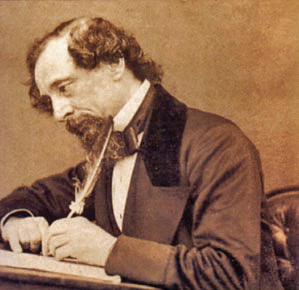
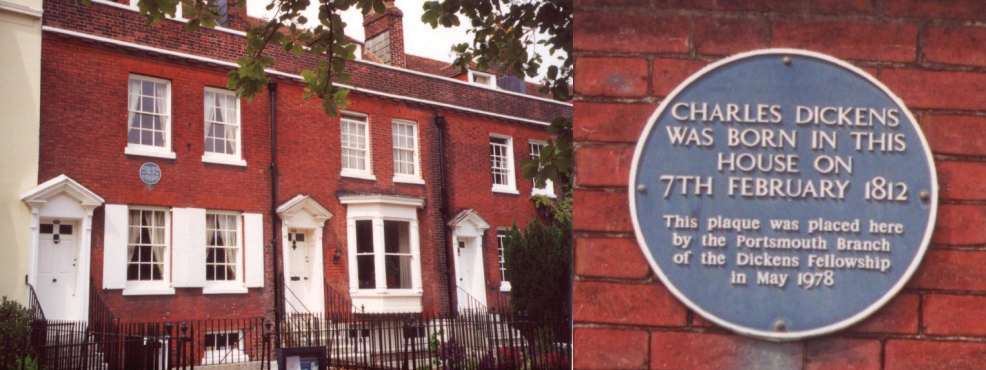
Dickens’s birthplace in Portsmouth.
Charles Dickens was born in 1812 in Portsmouth, a major port city in England. Although Dickens’s father worked as a clerk in a Navy office, he accrued debt and was imprisoned in Marshalsea Prison in London. Dickens’s mother and siblings joined him in prison, but at age twelve, Dickens went to work in a boot blacking factory in London to help support his family. The experiences he had there provided material for many of his novels that depict the working poor of London.
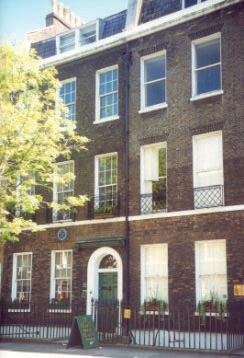
Forty-eight Doughty Street, the only surviving London house Dickens lived in. He was living here when he wrote Oliver Twist and Nicholas Nickleby.
When his father was released from prison, Dickens was able to attend school and eventually worked as an office assistant for an attorney, a position which led to his becoming a court reporter, a reporter in Parliament, and eventually a journalist. With the success of his first serialized novel, Pickwick Papers, Dickens became a full-time novelist. His novels quickly achieved mass popularity, audiences eagerly awaiting new installments of the serial novels. Always interested in the theatre, Dickens conducted a series of public readings of his novels, drawing large enthusiastic audiences in England, on the continent, and in America. The readings added to his fame but later in life proved harmful to his health. Against his doctor’s advice, he completed a final reading tour in America and several more readings in England until he died of a stroke in 1870. Not surprisingly for a writer of his prominence, he was buried in Poet’s Corner at Westminster Abbey.
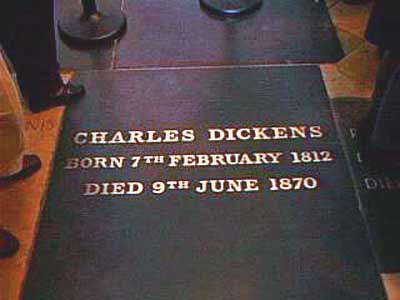
Text
- Dickens, Charles, 1812–1870. A Tale of Two Cities. Electronic Text Center, University of Virginia Library.
- A Tale of Two Cities by Charles Dickens. Project Gutenberg.
- A Tale of Two Cities by Charles Dickens. A. L. Burt Company, Publishers, New York. 1890. Hathi Trust Digital Library.
A Tale of Two Cities
Background
Published in 1859, A Tale of Two Cities is an example of a serial novel, a novel published in installments over a period of time. The novel was first published in weekly installments and again later in monthly installments.
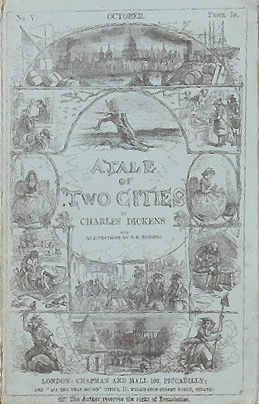
Cover of the serial volume of A Tale of Two Cities with artwork by Hablot Knight Browne, known as Phiz, who illustrated many of Dickens’s works.
Fears that England might be heading toward a revolution like the French Revolution persisted into the Victorian Era. Literary references to these fears appear in many 19th-century works including Wilde’s The Importance of Being Earnest; Barrett Browning’s “The Cry of the Children,” Shelley’s “Men of England,” and Byron’s Don Juan.
The passage of Reform Bills in 1832, 1867, and 1884 to extend voting rights evidences the discontent of the previously disenfranchised working class and the unease of the upper classes who feared open rebellion.
Structure
A Tale of Two Cities is divided into three sections:
- Book the First: Recalled to Life (1775)
- Book the Second: The Golden Thread (1780–1789)
- Book the Third: The Track of a Storm (1792–1793)
Setting
“Chapter 1 The Period” begins with these well-known lines:
It was the best of times,
it was the worst of times,
it was the age of wisdom,
it was the age of foolishness,
it was the epoch of belief,
it was the epoch of incredulity,
it was the season of Light,
it was the season of Darkness,
it was the spring of hope,
it was the winter of despair…
Although these lines do little to depict the actual setting, they provide a hint of the contrasts the novel develops, contrasts of normal life and the Reign of Terror, innocence and guilt, life and death. Dickens makes the lines poetic and memorable with the use of literary devices:
- AnaphoraLines which begin with the same word or phrase.. Lines which begin with the same word or phrase (it was, it was, it was…)
- AsyndetonDeletion of conjunctions between sentences or clauses.. Deletion of conjunctions between sentences or clauses
- ParallelismThe use of the same grammatical structure for ideas of equal importance.. The use of the same grammatical structure for ideas of equal importance
- ParadoxThe juxtaposition of seemingly contradictory ideas.. The juxtaposition of seemingly contradictory ideas
To introduce the period in which the novel is set, Chapter 1 moves from these lines to more specific paragraphs which establish the places (Paris and London), the time (1775), and the atmosphere (foreboding). The last lines of Chapter 1 refer to the road of destiny and provide a transition to a literal road: the mail on the road to Dover. And thus the story begins.
Characters
- Sydney Carton. Carton is described as virtually dead, “like one who died young.” He may be seen as a Byronic hero, a dark, brooding anti-hero, aware of the profligate path in life he chooses. However, he is also a redemptive figure connected to resurrection imagery—life through death—and to prophecy.
- Charles Darnay. Unlike Carton and Dr. Manette, Darnay is a static character, exemplifying the Victorian ideal of the nature of nobility—he is nobly born and chooses to act nobly.
- Dr. Manette. Dr. Manette is the most vivid example of the theme of resurrection and redemption, particularly the redeeming capacity of love. Readers learn that Dr. Manette had been a man of strength and character but has been driven to madness by the evils he endures in France. Rescued and brought to England, a place of safety and sanity, he recovers because of Lucie’s loving care and is transformed into a strong, decisive character capable of planning and implementing a daring rescue.
- Lucie. The name Lucie is from the Latin root lux, meaning light, and her character exudes goodness, symbolized by light. She occupies one end of the good-evil spectrum. Like Darnay, Lucie is a static, flat character, a stereotypical Victorian upper class woman.
- Madame DeFarge. Madame DeFarge is the other end of the good-evil spectrum although she has an explanation for her evil and desire for revenge. The image of Madame DeFarge knitting is, in addition to being one of the most famous images in British literature, the central image of the novel. Her knitting intimates the archetypal image of weaving to represent the threads of life, as suggested in the title of Part II, The Golden Thread.
- Ernest DeFarge. With a name signifying his role, Ernest DeFarge serves as a comparison and contrast with Madame DeFarge
- The Vengeance. The Vengeance is an allegorical characterA character who represents an abstract quality, creating two levels of meaning in a literary work., a character who represents an abstract quality, creating two levels of meaning in a literary work.
- Miss Pross. As Lucie is a stereotype of an upper class British woman, Miss Pross is a stereotype of a British working class woman, loyal and fiercely patriotic.
- Cruncher. The inclusion of a “resurrection man” amplifies, and in a subtle way satirizes, the theme of resurrection.
Cities as Characters
The title declares the story a tale of two cities. Paris and London become conveyances of theme: light and dark, good and evil, redemption and retribution.
Portraying London as a place of safety, of survival, even of sanity resonated with patriotic Victorian audiences, contributing to pride in the British Empire.
Themes
- Threads of destiny. The weaving or knitting motif serves as an archetypeAn image or symbol embedded in the collective unconsciousness of people from all cultures, an idea based on the psychological theory of Carl Jung., an image or symbol embedded in the collective unconscious of people from all cultures, an idea based on the psychological theory of Carl Jung. In mythology, the Fates weave, representing fate determining human destiny, gradually revealing the pattern of one’s life in their tapestry.
- Guilt and retribution. The French aristocracy is personified in St. Evrémondes, who in turn personifies guilt. Darnay is inextricably connected to the guilt as surely as he is related to St. Evrémondes, an example of the weaving together of various threads to form one’s destiny. Retribution is embodied in Madame DeFarge.
- Retribution and redemption. The contrast of retribution and redemption form a major theme of the novel, a theme in which almost all the characters play a role.
- The doppelganger. The word doppelganger, translated from German, literally means ‘double walker” or “double goer.” In folklore, the doppelganger is often a harbinger of death or an ill omen, not necessarily a physical double. Elements of the doppelganger in both senses function in A Tale of Two Cities.
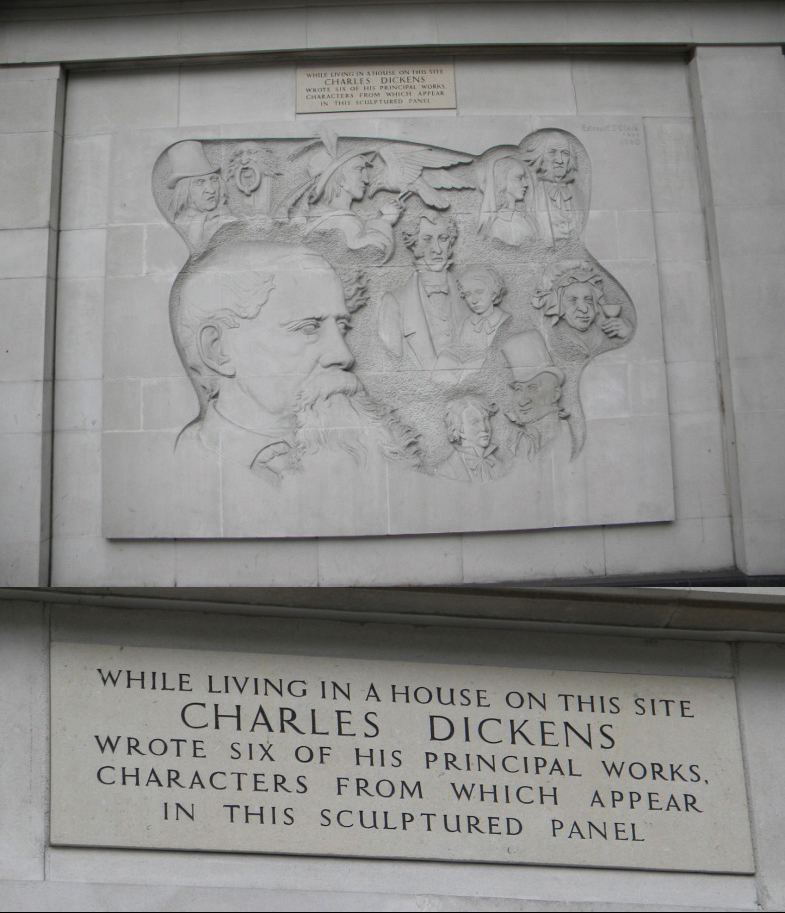
Key Takeaways
- Charles Dickens’s A Tale of Two Cities was published as a serial novel, a popular form of publication in the Victorian Era.
- The novel is structured in three parts, each part with a title that helps to convey theme.
- In the well-known opening lines, Dickens uses literary devices such as anaphora, asyndeton, parallelism, and paradox.
- The novel’s characters include both developing and static characters, both types contributing to the development of theme.
- Major themes of the novel are threads of destiny, guilt and retribution, and retribution and redemption.
Exercises
Structure and Theme
Consider the themes conveyed by the three-part structure.
-
Part I Recalled to Life
-
Who is recalled to life? Consider the following characters:
- Dr. Manette
- Charles Darnay
- Sydney Carton
- Jarvis Lorry
- Miss Pross
- How are these characters “recalled to life”?
- What is the purpose of Cruncher and his occupation, “resurrection man”?
-
-
Part II The Golden Thread
- How does Lucie function as a “golden thread,” weaving the events?
- Could Madame DeFarge function as a “golden thread”?
- What are the literal and figurative purposes of Madame DeFarge’s knitting?
-
Part III The Track of a Storm
- What personal “storms” erupt in Part III?
- What public “storms”?
Characters
- Trace the development of Sydney Carton’s character from his dissipated state to his redemption. What forces affect his developing character?
- Compare Lucie, the stereotypical Victorian upper class woman, with Miss Pross, the stereotypical Victorian lower class woman.
- Why doesn’t Madame DeFarge anticipate Carton’s action?
- What explanation does the novel provide for Madame DeFarge’s evil? After learning the explanation, do her actions seem justified?
- In what ways and why is The Vengeance different from Madame DeFarge?
- In what ways do the two cities represent “poetic justice,” with the “good guys” ending up in England and the “bad guys” ending up in France?
- Compare and contrast Dickens’s portrayal of London and Paris with the Romantic poets’ depiction of the pastoral countryside and the industrialized city.
Images
- Identify images of light and dark throughout the novel. What themes do these images support?
- Locate references to footsteps throughout the novel. What is the purpose of these references? Also consider Dr. Manette’s shoemaking; explain how it symbolizes the path he makes for his own and Lucie’s fate.
- List instances of the spilling of wine throughout the novel. How do these incidents function literally in the plot and figuratively in reinforcing theme?
Themes
- How do references to Lucie’s hair connect to the “threads of destiny” motif?
- How and why is Darnay different from his relative St. Evrémondes? How do his decisions and actions contribute to a destiny different from his uncle’s?
- What role does Dr. Manette’s letter play in the theme of guilt and retribution?
-
Almost all the characters in the novel play a role in developing the theme of retribution and redemption. Identify which of the following characters represent retribution and which represent redemption. After compiling this initial list, reconsider each character to determine those who are more complex, who embody elements of both retribution and redemption.
- Darnay
- Carton
- Dr. Manette
- Lorry
- Minor characters: Cruncher, Barsad
-
Identify examples of the doppelganger and describe their function in the novel. Include the following examples:
- London-Paris
- Darnay-Carton
- Lucie-Madame DeFarge and/or Miss Pross-Madame DeFarge
Resources
General Information
- “Charles Dickens.” The Victorian Web. George P. Landow, Brown University.
- David Perdue’s Charles Dickens Page.
- “Dickens in Context.” The British Library. includes videos and images.
- The Dickens Project. University of California.
Biography
- “Charles Dickens (1812–1870).” BBC History.
- “Charles Dickens—Biographical Information.” The Victorian Web. George P. Landow, Brown University.
- “Charles Dickens: The Life of the Author.” Kenneth Benson. The New York Public Library.
A Tale of Two Cities
- “A Tale of Two Cities.” Discovering Dickens—A Community Reading Project. Stanford University.
- “Some Discussions of Dickens’s A Tale of Two Cities.” The Victorian Web. George P. Landow, Brown University.
Text
- Dickens, Charles, 1812–1870. A Tale of Two Cities. Electronic Text Center, University of Virginia Library.
- A Tale of Two Cities by Charles Dickens. Project Gutenberg.
- A Tale of Two Cities by Charles Dickens. A. L. Burt Company, Publishers, New York. 1890. Hathi Trust Digital Library.
Video
- “Charles Dickens Animation.” BBC Home.
- “Virtual Guide for Charles Dickens Birthplace.” Portsmouth Museums and Records.
Audio
- “A Tale of Two Cities by Charles Dickens (1812–1870).” LibriVox.
- “A Tale of Two Cities.” Charles Dickens. Lit2Go. Florida Center for Instructional Technology, College of Education, University of South Florida.
Images
- “Charles Dickens.” Great Britons: Treasures from the National Portrait Gallery, London.
7.3 Emily Brontë (1818–1848)
PLEASE NOTE: This book is currently in draft form; material is not final.
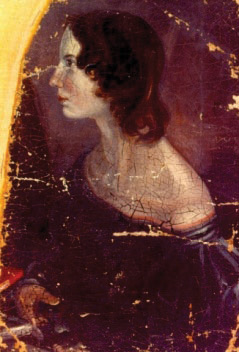
Learning Objectives
- List major characters, explain their roles in the plot, and analyze their characters within the novel and as they might be interpreted by both Victorian and contemporary audiences.
- Outline the chronology of the novel’s major events, and compare and correlate the chronology with the order in which events are presented in the novel.
- Assess the relationship between character and setting, and provide specific examples.
- Analyze the differences in relationships among the second generation and the third generation that allow the younger characters to resolve the novel’s conflicts.
Biography
The village of Haworth website offers virtual tours of the interior of the Brontë Parsonage Museum.
Text
- Wuthering Heights. Electronic Text Center, University of Virginia Library.
- Wuthering Heights by Emily Brontë. Project Gutenberg.
- Wuthering Heights and Agnes Grey. The Haworth Edition. New York and London. Harper & Brothers Publishers. 1900. Hathi Trust Digital Library.
Wuthering Heights (1846)
A novel, according to Holman and Harmon’s standard definition is an “extended fictional prose narrative.” A novel’s components include character, plot, structure, setting, and theme.
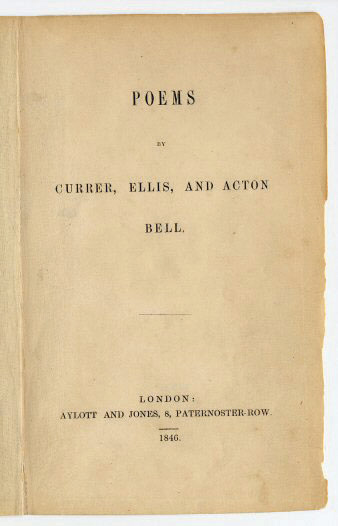
An 1846 edition of Poems showing the use of pen names, Currer, Ellis, and Acton Bell.

Emily Brontë’s drawing of herself and Anne writing at a table in the Bronté parsonage in Haworth. This sketch is on display in the Brontë Parsonage Museum in Haworth.
As in most novels, in Wuthering Heights character, plot, and structure are tightly interwoven; one element drives the others. Particularly significant in Wuthering Heights is setting, which Brontë uses to reflect character.
- Character: While contemporary audiences tend to read Wuthering Heights with a sympathetic view of Heathcliff and Catherine, Victorian audiences would have agreed that Edgar was the appropriate choice of a husband for Catherine. We may think that couples should follow their hearts, but a Victorian audience, particularly an upper or middle class audience, would have believed that Catherine had a duty to marry her social equal—Edgar. The conflict within Catherine as she feels torn between Heathcliff and Edgar is a focal point of the novel. Her death marks the transition between the two parts of the story. Of course, Wuthering Heights is largely Heathcliff’s story; his desire for revenge drives the plot.
- Plot: The main story is told as a flashbackThe insertion of an event from earlier in the natural chronology that interrupts the narrative., the insertion of an event from earlier in the natural chronology that interrupts the narrative. The story opens with the arrival of Lockwood at Wuthering Heights. After his nightmarish encounter with the apparition of Catherine, Nelly Dean begins to tell Lockwood the story of the Earnshaws and the Lintons. Most of the book, then, is her narration of events that have already happened. The final chapters return to the novel’s present, the time of Lockwood, as the conflicts are resolved.
- Structure: The structure of Wuthering Heights is built on the three generations of characters in the story: the older generation (who set in motion the conflicts); their children (who comprise the conflicts of the novel); and the youngest generation (who resolve the conflicts). Through these three layers of characters runs a connecting thread in the character of Heathcliff. Providing a framework for this structure are the narrations of Nelly and Lockwood.
- Setting: The characteristics of the two families, the Earnshaws and the Lintons, are reflected in their homes, Wuthering Heights and Thrushcross Grange. Even the weather is used to mirror the emotions of the characters.

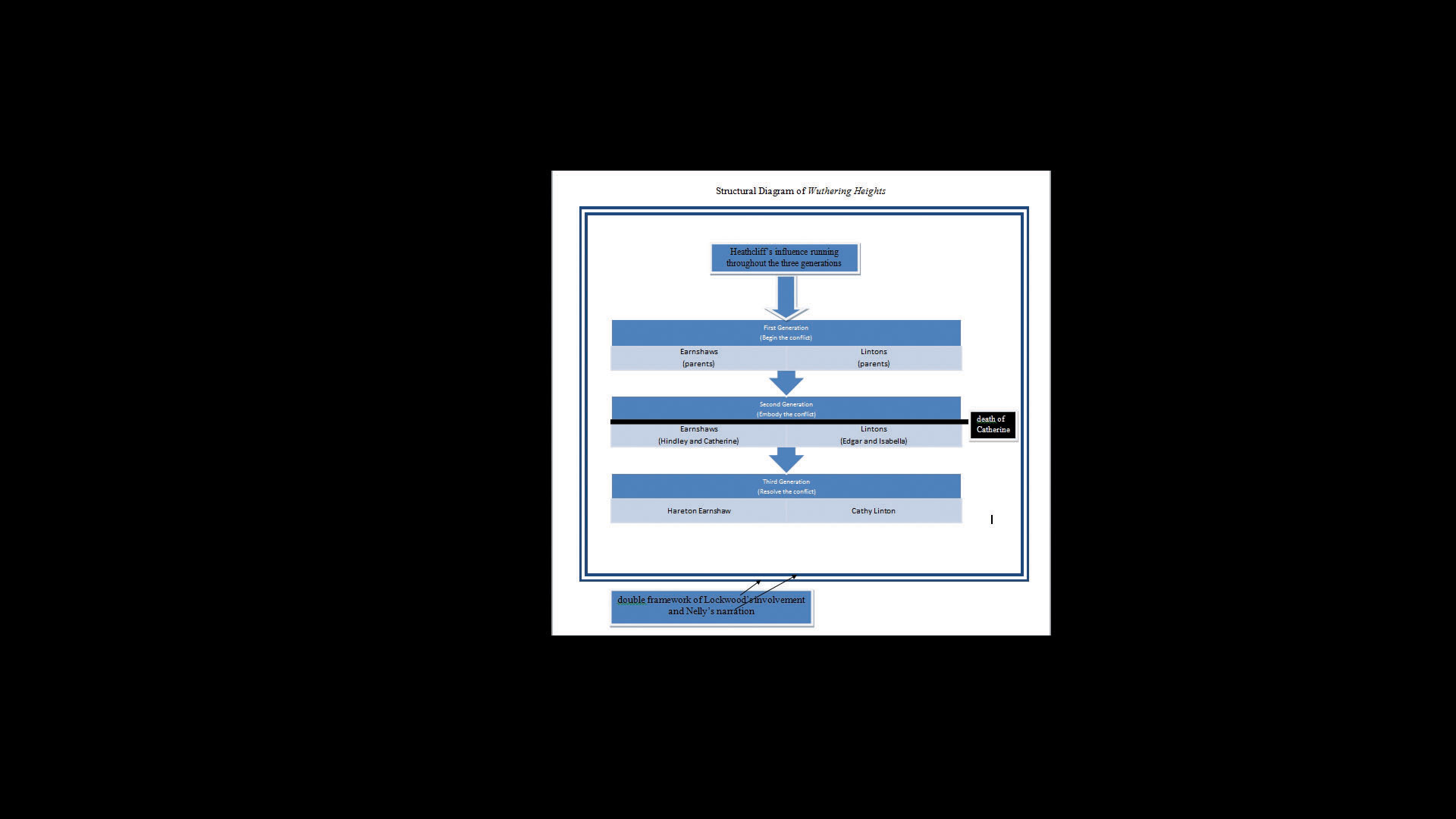
A structural diagram of Wuthering Heights.
Video Clip 3
Emily Brontë and the Yorkshire Moors
(click to see video)View a video mini-lecture about Emily Bronte and the Yorkshire Moors.
Key Takeaways
- Heathcliff, the structurally central character of the novel, is a Byronic hero, generally sympathetic to modern audiences but generally unsympathetic to Victorian audiences.
- Wuthering Heights and Thrushcross Grange reflect the characters who live there, and conflict occurs when Catherine attempts to cross the social boundaries represented by the estates, boundaries well established for Victorian audiences.
- Setting, including the weather, reflects character.
- The third generation resolves the conflicts, in part by overcoming the social restrictions that bound their parents.
Exercises
Catherine
- How does Brontë depict Catherine’s attachment to Heathcliff when they were children? What character traits do Catherine and Heathcliff share that might have drawn them to each other? Identify specific events or specific character traits.
- How does Catherine change after her stay with the Lintons at Thrushcross Grange? How do the changes affect her relationship with Heathcliff?
- After Catherine’s stay with the Lintons, it becomes clear that she has developed a relationship with Edgar Linton. How would you describe that relationship? How does it affect her relationship with Heathcliff? What factors in society or in Catherine herself affect her feelings about each man?
- What reasons does Catherine give in her conversation with Nelly for deciding to marry Edgar? How does Nelly respond to her reasoning? During this conversation, Nelly is aware that Heathcliff is listening to part of the conversation although Catherine is not. How does Nelly’s decision not to tell Catherine affect the events of the novel? Why did Nelly make the decision not to reveal that Heathcliff was there?
- What does Catherine mean when she says, “I am Heathcliff”?
- Catherine is often described as having a dual personality or a split personality. She feels drawn in contradictory directions, torn between Edgar and Heathcliff. In fact, her death is attributed to this duality that she is unable to reconcile. What events bring about the crisis that results in her death?
- When Heathcliff returns after Catherine is married to Edgar, Catherine seems surprised that Nelly, Edgar, and society in general disapprove of her continuing her friendship with Heathcliff. Why would she expect to continue what society sees as an improper relationship? At the end of the novel, Catherine is buried between Edgar and Heathcliff wearing a locket that contains a lock of each man’s hair. How do you characterize Catherine’s relationship with the two men?
Heathcliff
- Emily Brontë’s sister Charlotte Brontë wrote a preface for the 1850 edition of Wuthering Heights in which she stated, “Whether it is right or advisable to create beings like Heathcliff, I do not know: I scarcely think it is.” Heathcliff is a Byronic anti-hero; in Victorian eyes he would be seen as an evil person without redeeming qualities, the opinion Charlotte Brontë expressed. Modern audiences might be more inclined to see Heathcliff as a product of his environment. What childhood events and relationships contribute to the warping of Heathcliff’s personality?
- When Nelly informs Heathcliff that Catherine has died, Heathcliff cries out for Catherine to “haunt” him. What evidence indicates that she does, figuratively or literally?
- When Hindley dies, Heathcliff determines to bring up Hareton himself at Wuthering Heights. He comments to Hareton, “Now, my bonny lad, you are mine! And we’ll see if one tree won’t grow as crooked as another, with the same wind to twist it!” What does Heathcliff mean? What does this comment reveal about Heathcliff’s character?
- What incident when Hareton was small indicates that Heathcliff may have some concern for him?
- Describe Heathcliff’s treatment of his wife Isabella and his son Linton.
- Near the end of the novel, Heathcliff’s desire for revenge seems to burn itself out. What causes this change, and what incidents illustrate his decreasing interest in life?
The Younger Generation
- Describe young Cathy when Lockwood first meets her. Describe her relationship with Hareton and the reasons for it.
- Describe Hareton as he appears when Lockwood first meets him. How has his life been similar to Heathcliff’s? Although he has experienced some of the same difficulties, he has not become hardened, or even evil, like Heathcliff; why? Do internal characteristics or outside influences temper his character?
- Although Linton is a pathetic character, he is not entirely sympathetic. How would you describe him? How would you account for his selfish, petty behavior?
- Describe Cathy and Hareton when Lockwood meets them again at the end of the novel. What has caused the change? How is that change reflected in the physical description of Wuthering Heights?
- How would you compare Cathy and Hareton with Catherine and Heathcliff?
The Settings
- Describe Wuthering Heights as it appears at the beginning of the novel. How is the description different at the end of the novel?
- How does weather function to reveal character? Consider the snowstorm at the beginning of the story, the storm the night Heathcliff leaves, and the weather at the end of the novel.
- How do the settings of the moors and the valley function to reveal character?
- Compare Wuthering Heights and Thrushcross Grange. How do the two estates reflect the characters who live there?
Resources
General Information
- “The Brontës.” The Brontë Parsonage Museum & Brontë Society.
- “Emily Brontë (1818–48).” The Victorian Web. links to biographical and critical information.
- “’Haworth, November 1904’ by Virginia Woolf.” Mary Mark Ockerbloom, ed. A Celebration of Women Writers.
- “Love on the Moors: The Bronte Family.” Sublime Anxiety: The Gothic Family and The Outsider. University of Virginia.
- “Overview of Emily Brontë.” Emily Brontë. Lilia Melani, Brooklyn College, City University of New York.
- “The Romantic Novel, Romanticism, and Wuthering Heights.” Lilia Melani, Brooklyn College, City University of New York.
Biography
- “Emily Jane Brontë.” The Brontë Parsonage Museum & Brontë Society.
- “Emily Jane Brontë: Poet and Novelist (1818–48).” The Victorian Web. Philip V. Allingham, Lakehead University.
Text
- Wuthering Heights. Electronic Text Center, University of Virginia Library.
- Wuthering Heights by Emily Brontë. Project Gutenberg.
- Wuthering Heights and Agnes Grey. The Haworth Edition. New York and London. Harper & Brothers Publishers. 1900. Hathi Trust Digital Library.
Audio
- Wuthering Heights. Learn Out Loud.com.
- Wuthering Heights. LibriVox.
Video
- Emily Bronte. Dr. Carol Lowe, McLennan Community College.
- Emily Bronte and the Yorkshire Moors. Dr. Carol Lowe, McLennan Community College.
Concordance
- “A Hyper-Concordance to the Works of the Brontë Sisters.” The Victorian Literary Studies Archive. Prof. Mitsu Matsuoka, Nagoya University.
7.4 Elizabeth Barrett Browning (1806–1861)
PLEASE NOTE: This book is currently in draft form; material is not final.
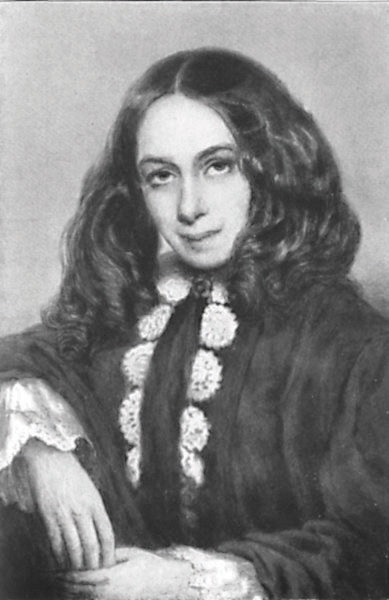
Learning Objectives
- Characterize Sonnets from the Portuguese as a sonnet sequence.
- Analyze and evaluate Barrett Browning’s “The Cry of the Children” as persuasive discourse.
Biography
PowerPoint 7.1.
Follow-along file: PowerPoint title and URL to come.
Texts
- “The Cry of the Children.” Edmund Clarence Stedman, ed. A Victorian Anthology, 1837–1895. Bartleby.com.
- “The Cry of the Children” in The Poetical Works of Elizabeth Barrett Browning. London: Oxford University Press, 1920. Hathi Trust Digital Library.
- “The Cry of the Children” in The Poetical Works of Elizabeth Barrett Browning. Project Gutenberg.
- Sonnets from the Portuguese. London: George Bell and Sons, 1900. Google Books.
- Sonnets from the Portuguese. Project Gutenberg.
- Sonnets from the Portuguese in The Poetical Works of Elizabeth Barrett Browning. London: Oxford University Press, 1920. Hathi Trust Digital Library.
Sonnets from the Portuguese
Barrett Browning’s sonnets were written to express her feelings for her husband Robert Browning. She never intended that they be published but acquiesced to her husband’s opinion that the poems were too good to keep from the world. Various biographers have attempted to explain the title: “Portuguese” was supposedly a pet name Browning had for his wife. Or the title may have been intended to disguise the biographical nature of the poems by suggesting that they were translated from the Portuguese language.
Sonnets from the Portuguese form a sonnet sequenceA group of sonnets exploring all aspects of a topic., a group of sonnets exploring all aspects of a topic, a form of literature that had reached its height of popularity in the 16th century. Barrett Browning uses the form to trace the growth of a love, at first tentative, then more self-assured as the sequence progresses.
Sonnet 43
How do I love thee? Let me count the ways.
I love thee to the depth and breadth and height
My soul can reach, when feeling out of sight
For the ends of Being and ideal Grace.
I love thee to the level of everyday’s
Most quiet need, by sun and candle-light.
I love thee freely, as men strive for Right;
I love thee purely, as they turn from Praise.
I love thee with the passion put to use
In my old griefs, and with my childhood’s faith.
I love thee with a love I seemed to lose
With my lost saints!—I love thee with the breath,
Smiles, tears, of all my life!—and, if God choose,
I shall but love thee better after death.
Sonnet 43 is one of the world’s best known poems. The first line, “How do I love thee? Let me count the ways,” surely figures in the most often quoted poetic lines.
The poet recounts eight ways in which she loves:
- Her love is as expansive as the space her soul is capable of reaching.
- Her love encompasses everyday moments, by night and day, in contrast to the expansive metaphor of the first “way of loving.”
- Her love is freely given. She compares this gift of love to the way men voluntarily strive for the things they believe in.
- Her love is pure as the men fighting for their beliefs do so from pure motives, not for glory or honor.
- Her love is as intense as the passions she felt in her childhood.
- Her love is as intense as the love she thought she’d lost when she lost her childhood “saints,” perhaps a reference to loved ones she lost through death, or perhaps a reference to disillusionment—learning that people she considered “saints” are not perfect.
- Her love lasts through “smiles” and “tears,” good and bad experiences.
- Her love will last even after death.
“The Cry of the Children”
“Pheu, pheu, ti prosderkesthe m’ ommasin, tekna?”’
Medea
I.
Do ye hear the children weeping, O my brothers,
Ere the sorrow comes with years?
They are leaning their young heads against their mothers.
And that cannot stop their tears.
The young lambs are bleating in the meadows,
The young birds are chirping in the nest,
The young fawns are playing with the shadows,
The young flowers are blowing toward the west—
But the young, young children, O my brothers,
They are weeping bitterly!
They are weeping in the playtime of the others,
In the country of the free.
II.
Do you question the young children in the sorrow
Why their tears are falling so?
The old man may weep for his to-morrow
Which is lost in Long Ago;
The old tree is leafless in the forest,
The old year is ending in the frost,
The old wound, if stricken, is the sorest,
The old hope is hardest to be lost:
But the young, young children, O my brothers,
Do you ask them why they stand
Weeping sore before the bosoms of their mothers,
In our happy Fatherland?
III.
They look up with their pale and sunken faces,
And their looks are sad to see,
For the man’s hoary anguish draws and presses
Down the cheeks of infancy;
“Your old earth,” they say, “is very dreary,
Our young feet,” they say, “are very weak;
Few paces have we taken, yet are weary—
Our grave-rest is very far to seek:
Ask the aged why they weep, and not the children,
For the outside earth is cold,
And we young ones stand without, in our bewildering,
And the graves are for the old.”
IV.
“True,” say the children, “it may happen
That we die before our time:
Little Alice died last year, her grave is shapen
Like a snowball, in the rime.
We looked into the pit prepared to take her:
Was no room for any work in the close clay!
From the sleep wherein she lieth none will wake her,
Crying, ‘Get up, little Alice! it is day.’
If you listen by that grave, in sun and shower,
With your ear down, little Alice never cries;
Could we see her face, be sure we should not know her,
For the smile has time for growing in her eyes:
And merry go her moments, lulled and stilled in
The shroud by the kirk-chime.
It is good when it happens,” say the children,
“That we die before our time.”
V.
Alas, alas, the children! they are seeking
Death in life, as best to have:
They are binding up their hearts away from breaking,
With a cerement from the grave.
Go out, children, from the mine and from the city,
Sing out, children, as the little thrushes do;
Pluck your handfuls of the meadow-cowslips pretty,
Laugh aloud, to feel your fingers let them through!
But they answer, “Are your cowslips of the meadows
Like our weeds anear the mine?
Leave us quiet in the dark of the coal-shadows,
From your pleasures fair and fine!
VI.
“For oh,” say the children, “we are weary,
And we cannot run or leap;
If we cared for any meadows, it were merely
To drop down in them and sleep.
Our knees tremble sorely in the stooping,
We fall upon our faces, trying to go;
And, underneath our heavy eyelids drooping,
The reddest flower would look as pale as snow.
For, all day, we drag our burden tiring
Through the coal-dark, underground;
Or, all day, we drive the wheels of iron
In the factories, round and round.
VII.
“For all day the wheels are droning, turning;
Their wind comes in our faces,
Till our hearts turn, our heads with pulses burning,
And the walls turn in their places:
Turns the sky in the high window, blank and reeling,
Turns the long light that drops adown the wall,
Turn the black flies that crawl along the ceiling:
All are turning, all the day, and we with all.
And all day the iron wheels are droning,
And sometimes we could pray,
‘O ye wheels’ (breaking out in a mad moaning),
‘Stop! be silent for to-day!’”
VIII.
Ay, be silent! Let them hear each other breathing
For a moment, mouth to mouth!
Let them touch each other’s hands, in a fresh wreathing
Of their tender human youth!
Let them feel that this cold metallic motion
Is not all the life God fashions or reveals:
Let them prove their living souls against the notion
That they live in you, or under you, O wheels!
Still, all day, the iron wheels go onward,
Grinding life down from its mark;
And the children’s souls, which God is calling sunward,
Spin on blindly in the dark.
IX.
Now tell the poor young children, O my brothers,
To look up to Him and pray;
So the blessed One who blesseth all the others,
Will bless them another day.
They answer, “Who is God that He should hear us,
While the rushing of the iron wheels is stirred?
When we sob aloud, the human creatures near us
Pass by, hearing not, or answer not a word.
And we hear not (for the wheels in their resounding)
Strangers speaking at the door:
Is it likely God, with angels singing round Him,
Hears our weeping any more?
X.
“Two words, indeed, of praying we remember,
And at midnight’s hour of harm,
‘Our Father,’ looking upward in the chamber,
We say softly for a charm.[1]
We know no other words except ‘Our Father,’
And we think that, in some pause of angels’ song,
God may pluck them with the silence sweet to gather,
And hold both within His right hand which is strong.
‘Our Father!’ If He heard us, He would surely
(For they call Him good and mild)
Answer, smiling down the steep world very purely,
‘Come and rest with me, my child.’
XI.
“But, no!” say the children, weeping faster,
“He is speechless as a stone:
And they tell us, of His image is the master
Who commands us to work on.
Go to!” say the children,—“up in Heaven,
Dark, wheel-like, turning clouds are all we find.
Do not mock us; grief has made us unbelieving:
We look up for God, but tears have made us blind.”
Do you hear the children weeping and disproving,
O my brothers, what ye preach?
For God’s possible is taught by His world’s loving,
And the children doubt of each.
XII.
And well may the children weep before you!
They are weary ere they run;
They have never seen the sunshine, nor the glory
Which is brighter than the sun.
They know the grief of man, without its wisdom;
They sink in man’s despair, without its calm;
Are slaves, without the liberty in Christdom,
Are martyrs, by the pang without the palm:
Are worn as if with age, yet unretrievingly
The harvest of its memories cannot reap,—
Are orphans of the earthly love and heavenly.
Let them weep! let them weep!
XIII.
They look up with their pale and sunken faces,
And their look is dread to see,
For they mind you of their angels in high places,
With eyes turned on Deity.
“How long,” they say, “how long, O cruel nation,
Will you stand, to move the world, on a child’s heart,—
Stifle down with a mailed heel its palpitation,
And tread onward to your throne amid the mart?
Our blood splashes upward, O gold-heaper,
And your purple shows your path!
But the child’s sob in the silence curses deeper
Than the strong man in his wrath.”
The epigraph to Barrett Browning’s poem from Euripides’s Greek tragedy Medea may be translated, “Woe, woe, why do you look at me with your eyes, children?” Stanzas 1 and 2 begin with questions for Barrett Browning’s readers, directing their attention to the children’s tears. The suffering and sorrow felt by the children is to be expected only in a much older person, one who has lived long enough to experience life’s hardships.
Stanza 4 relates the children’s reactions to the death of Alice, one of the children. The children peer into her grave, noting that there is no room for her to do the work she’s been used to. Alice will never again hear someone calling her from her bed at dawn to resume her work, and the children do not hear her crying from her grave. Based on these observations, in their childish reasoning, they conclude that death is preferable to life.
Stanzas 5 and following address the children’s relationship to nature and to God while always pleading with the reader to recognize the children’s plight. The last stanza addresses the reader directly with a condemnation of a society that allows this situation to exist.
Key Takeaways
- “Sonnets from the Portuguese” is a sonnet sequence.
- “The Cry of the Children” is persuasive discourse.
- “The Cry of the Children” drew on published government documents inquiring into child labor abuses.
Exercises
- “The Cry of the Children” falls into the category of persuasive discourse. Who is Barrett Browning attempting to persuade? Of what is she attempting to persuade her audience? Persuasive discourse uses logical (logos) and emotional appeal (pathos); what examples of each type of appeal do you find in this poem?
-
Read some of the following documents from the Victorian era about child labor:
- “Testimony Gathered by Ashley’s Mines Commission.” The Victorian Web. Laura Del Col, West Virginia University.
- “Early Factory Legislation.” Reforming Society in the 19th Century. Living Heritage. www.parliament.uk.
- “The 1833 Factory Act.” Reforming Society in the 19th Century. Living Heritage. www.parliament.uk.
- “News on Mine Accidents.” Victorian Britain: An Industrial Nation. National Archives.
- “Child Miners.” Victorian Britain: An Industrial Nation. National Archives.
Which do you find more persuasive, Barrett Browning’s poem or the documents? Which do you think would have been more effective in convincing a Victorian audience to take action?
- Barrett Browning uses descriptions of nature although there is no hint of Romantic mysticism. What is the purpose of the natural descriptions in “The Cry of the Children”?
- Barrett Browning also uses frequent references to wheels. What is the literal and metaphorical meaning of the wheels? An apostrophe is an address to an inanimate object or an abstract quality. In stanzas 7 and 8, Barrett Browning addresses the wheels; what is the purpose of this apostrophe?
- Compare Barrett Browning’s description of the children and their lives with Blake’s Songs of Innocence and Experience, particularly in the “Holy Thursday” and “Chimney Sweeper” poems. Compare the children’s attitude toward religion in both authors’ works. Compare the line “if all do their duty we need not fear harm” from the Innocence “The Chimney Sweeper” with the last stanza of “The Cry of the Children.”
Resources
Biography
- The Browning Letters. Baylor University and Wellesley College.
- “Elizabeth Barrett Browning.” The Browning Society.
- “Elizabeth Barrett Browning (1806–1861).” The Brownings. Armstrong Browning Library. Baylor University.
- Elizabeth Barrett Browning—Biographical Materials. The Victorian Web. George P. Landow, Brown University.
- “Guidi House—Casa Guidi.” The Museums of Florence.
Texts
- “The Cry of the Children” in The Poetical Works of Elizabeth Barrett Browning. London: Oxford University Press, 1920. Hathi Trust Digital Library.
- “The Cry of the Children” in The Poetical Works of Elizabeth Barrett Browning. Project Gutenberg.
- Sonnets from the Portuguese in The Poetical Works of Elizabeth Barrett Browning. London: Oxford University Press, 1920. Hathi Trust Digital Library.
- Sonnets from the Portuguese. Project Gutenberg.
Audio
- “The Cry of the Children.” LibriVox.
- Sonnets from the Portuguese. LibriVox.
- Sonnets from the Portuguese. Project Gutenberg.
Video
- “Robert Browning and Elizabeth Barrett Browning.” Dr. Carol Lowe. McLennan Community College.
7.5 Robert Browning (1812–1889)
PLEASE NOTE: This book is currently in draft form; material is not final.
Learning Objectives
- Define dramatic monologue and apply the definition to appropriate poems by Robert Browning.
- Define lyric and apply the definition to appropriate poems by Robert Browning.
- Describe the speakers in “Porphyria’s Lover,” “My Last Duchess,” and “The Bishop Orders His Tomb at St. Praxed’s Church.” Consider their words, implied actions, tone, and inferences drawn from their speeches.
Biography
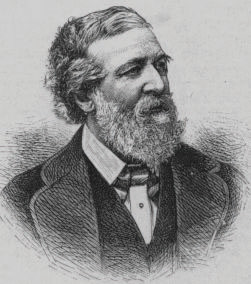
Robert Browning was born in 1812, the son of a prosperous bank clerk and a nonconformist, musical mother. His father collected a voluminous library, and, disliking school, Browning grew up largely self educated in his father’s library, both he and his sister Sarianna immersed in a household filled with music, art, and literature. His early poems, such as Pauline and Paracelsus, attracted little attention. Encouraged by an actor friend, William Macready, Browning attempted to write several plays, none of which was particularly successful on stage. His next published long poem Sordello was ravaged by critics and popular writers of the time, such as Tennyson and Thomas Carlyle, and earned Browning a reputation for “obscurity” which persists to the present.
Browning’s attempts at writing plays did lead him to develop a form for which he is most well-known, the dramatic monologue, a poem spoken by a single speaker to a recognizable but silent audience at a critical moment in the speaker’s life. Although he did not invent the dramatic monologue form, he perfected it and used it so well that it has come to be closely associated with Browning.
The negative critical reception much of Browning’s early work received may account for the exceptional notice he took of Elizabeth Barrett’s mention of him in her poem “Lady Geraldine’s Courtship”:
Or from Browning some “Pomegranate,” which, if cut deep down the middle, shows a heart within blood-tinctured of a veined humanity.
Feeling as if he’d found someone who understood his poetry, Browning began corresponding with Barrett and, through mutual friend John Kenyon, one of London’s literati, arranged to meet her. After their marriage and move to Florence, Italy, the most productive period of Browning’s life began with the publication of Men and Women in 1855.
Browning’s magnum opus The Ring and the Book is a verse novel consisting of twelve books, ten books presenting ten dramatic monologues recounting a sensational murder trial that took place in Italy in 1698. In the introductory Book I, Browning describes walking through a street market in Florence and purchasing what he called The Old Yellow Book, a compilation of documents pertaining to the trial from which he drew the story conveyed in The Ring and the Book. This is the “Book” of the title. The “Ring” of the title may refer to an actual ring or to the ring of stories which attempt to arrive at the truth of the murder case. The verse novel is an experiment in dialectical writing, a story told through nine different filters (one character, the murderer Guido Franceschini, speaks two books), nine characters with their own preconceptions and circumstances which color their versions of the truth. The speakers of the monologues reveal as much about themselves as they do about the murder—which is the main purpose of a dramatic monologue: to reveal the character of the speaker.
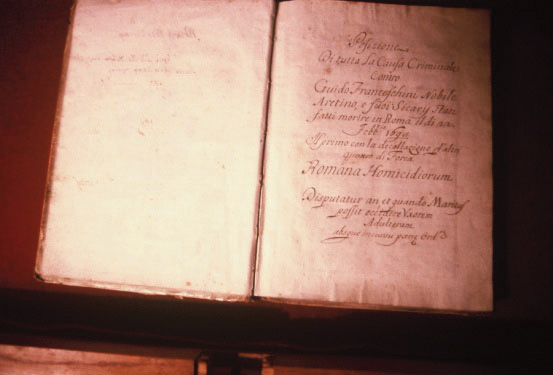
The Old Yellow Book on display in the Browning Room at Balliol College, Oxford.
By the time of his death in 1889, Browning had become a major figure in England’s literary scene. He was buried in Westminster Abbey’s Poets Corner although he had expressed to his son his desire to be buried next to his wife Elizabeth Barrett Browning in Florence, Italy.
Texts
- “The Bishop Orders His Tomb at St. Praxed’s Church Rome, 15—.” Representative Poetry Online. Ian Lancashire, Department of English, University of Toronto. University of Toronto Libraries.
- “The Bishop Orders His Tomb at St. Praxed’s Church, 15—.” The Victorian Web. Dr. George Landow, Brown University.
- “Home Thoughts from Abroad.” Representative Poetry Online. Ian Lancashire, Department of English, University of Toronto. University of Toronto Libraries.
- “My Last Duchess.” Representative Poetry Online. Ian Lancashire, Department of English, University of Toronto. University of Toronto Libraries.
- “My Last Duchess.” The Victorian Web. Dr. George Landow, Brown University.
- “Porphyria’s Lover.” Representative Poetry Online. Ian Lancashire, Department of English, University of Toronto. University of Toronto Libraries.
- “Porphyria’s Lover.” The Victorian Web. Dr. George Landow, Brown University.
- “Prospice.” Representative Poetry Online. Ian Lancashire, Department of English, University of Toronto. University of Toronto Libraries.
The Dramatic Monologue
From John Donne in the 17th century to Robert Burns in the late 18th century, poets wrote dramatic monologues. Browning, however, is most often associated with the form, and his dramatic monologues are considered his best poems.
Although the dramas that Browning wrote early in his career were not successful as theater productions, they reveal a gift for creating fictional characters and presenting them through their speeches. While this made “talky,” uninteresting stage presentations, it created dynamic poetry.
A dramatic monologue has the following four characteristics:
- a fictional speaker
- a speech made at a dramatic moment in the speaker’s life
- a silent but identifiable listener
- a revelation of the speaker’s character
Think of a dramatic monologue as a scene in a play, but a scene in which only one of the characters on stage speaks. The “I” of a dramatic monologue is not the poet; the poet makes up a character who delivers the speech. It is this fictional character whose life and thoughts we hear about.
The speech that is the dramatic monologue is given at a dramatic moment in the speaker’s life; some significant event has or is about to occur.
The existence of a silent but identifiable listener means that the speaker is not the only character present in this scene. We can tell from the speaker’s comments that another person (or persons) is present, but the poem contains only the words of the speaker.
A dramatic monologue reveals the character of the speaker. By hearing what s/he says, we know what kind of person s/he is.
Robert Browning was interested in psychology; his dramatic monologues give us insight into a variety of people—some good, some evil. In “Porphyria’s Lover,” for example, Browning takes his audience into the mind of a psychotic man. We wonder how someone could commit such a violent act, and Browning’s poem attempts to let us see how this criminally insane mind works.
Porphyria’s Lover
The rain set early in tonight,
The sullen wind was soon awake,
It tore the elm-tops down for spite,
And did its worst to vex the lake:
I listened with heart fit to break.
When glided in Porphyria; straight
She shut the cold out and the storm,
And kneeled and made the cheerless grate
Blaze up, and all the cottage warm;
Which done, she rose, and from her form
Withdrew the dripping cloak and shawl,
And laid her soiled gloves by, untied
Her hat and let the damp hair fall,
And, last, she sat down by my side
And called me. When no voice replied,
She put my arm about her waist,
And made her smooth white shoulder bare,
And all her yellow hair displaced,
And, stooping, made my cheek lie there,
And spread, o’er all, her yellow hair,
Murmuring how she loved me—she
Too weak, for all her heart’s endeavor,
To set its struggling passion free
From pride, and vainer ties dissever,
And give herself to me forever.
But passion sometimes would prevail,
Nor could tonight’s gay feast restrain
A sudden thought of one so pale
For love of her, and all in vain:
So, she was come through wind and rain.
Be sure I looked up at her eyes
Happy and proud; at last l knew
Porphyria worshiped me: surprise
Made my heart swell, and still it grew
While I debated what to do.
That moment she was mine, mine, fair,
Perfectly pure and good: I found
A thing to do, and all her hair
In one long yellow string l wound
Three times her little throat around,
And strangled her. No pain felt she;
I am quite sure she felt no pain.
As a shut bud that holds a bee,
I warily oped her lids: again
Laughed the blue eyes without a stain.
And l untightened next the tress
About her neck; her cheek once more
Blushed bright beneath my burning kiss:
I propped her head up as before,
Only, this time my shoulder bore
Her head, which droops upon it still:
The smiling rosy little head,
So glad it has its utmost will,
That all it scorned at once is fled,
And I, its love, am gained instead!
Porphyria’s love: she guessed not how
Her darling one wish would be heard.
And thus we sit together now,
And all night long we have not stirred,
And yet God has not said a word!
“My Last Duchess” is based on an historical incident involving the Duke of Ferrara, Italy during the Renaissance.
My Last Duchess
Ferrara
That’s my last Duchess painted on the wall,
Looking as if she were alive. I call
That piece a wonder, now: Frà Pandolf’s hands
Worked busily a day, and there she stands.
Will’t please you sit and look at her? I said
“Frà Pandolf” by design: for never read
Strangers like you that pictured countenance,
The depth and passion of its earnest glance,
But to myself they turned (since none puts by
The curtain I have drawn for you, but I)
And seemed as they would ask me, if they durst,
How such a glance came there; so, not the first
Are you to turn and ask thus. Sir, ‘twas not
Her husband’s presence only, called that spot
Of joy into the Duchess’ cheek: perhaps
Frà Pandolf chanced to say “Her mantle laps
Over my lady’s wrist too much,” or “Paint
Must never hope to reproduce the faint
Half-flush that dies along her throat:” such stuff
Was courtesy, she thought, and cause enough
For calling up that spot of joy. She had
A heart—how shall I say?—too soon made glad,
Too easily impressed; she liked whate’er
She looked on, and her looks went everywhere.
Sir, ‘twas all one! My favour at her breast,
The dropping of the daylight in the West,
The bough of cherries some officious fool
Broke in the orchard for her, the white mule
She rode with round the terrace—all and each
Would draw from her alike the approving speech,
Or blush, at least. She thanked men,—good! but thanked
Somehow—I know not how—as if she ranked
My gift of a nine-hundred-years-old name
With anybody’s gift. Who’d stoop to blame
This sort of trifling? Even had you skill
In speech—(which I have not)—to make your will
Quite clear to such an one, and say, “Just this
Or that in you disgusts me; here you miss,
Or there exceed the mark”—and if she let
Herself be lessoned so, nor plainly set
Her wits to yours, forsooth, and made excuse,
—E’en then would be some stooping: and I choose
Never to stoop. Oh, sir, she smiled, no doubt,
Whene’er I passed her; but who passed without
Much the same smile? This grew; I gave commands;
Then all smiles stopped together. There she stands
As if alive. Will’t please you rise? We’ll meet
The company below, then. I repeat,
The Count your master’s known munificence
Is ample warrant that no just pretence
Of mine for dowry will be disallowed;
Though his fair daughter’s self, as I avowed
At starting, is my object. Nay, we’ll go
Together down, sir. Notice Neptune, though,
Taming a sea-horse, thought a rarity,
Which Claus of Innsbruck cast in bronze for me!
“The Bishop Orders His Tomb at St. Praxed’s Church” also takes place in Renaissance Italy. The Bishop is on his deathbed and addresses “Nephews—sons mine…ah, God I know not!” In the next line he refers to his long-ago mistress. The implication of calling the priests gathered around his bed first nephews then sons followed immediately by a reference to his mistress is that he has fathered them but, as a priest, has pretended they are his nephews for so long that now, in the confusion of his mind as he faces death, he is not sure of the truth himself. The Bishop continues throughout his monologue to reveal that he is far from a devout clergyman.
His purpose in calling his sons/nephews to his deathbed is, as the title states, to order his tomb, to give them instructions for constructing his monument in the church. He compares himself and the tomb he wants to that of his rival in life, Gandalf. We learn that they were rivals for everything from position in the church to the mistress that bore his children.
The Bishop orders the finest, most expensive of materials and the most elaborate of ornamentation. The extent of the Bishop’s depravity is revealed in lines such as these when he describes the items he wants carved on his tomb:
The Saviour at his sermon on the mount,
Saint Praxed in a glory, and one Pan
Ready to twitch the Nymph’s last garment off,
And Moses with the tables
The sacrilegious combination of Christ, Moses, and a saint with the mythological Pan taking off a girl’s clothes represents the combination of sacred and profane that has been his life. Overall, the audience is struck foremost by the fact that in the Bishop’s last moments of life, his thoughts are not of his God and the state of his immortal soul but of material and worldly matters.
Lyric Poems
Although Browning is known primarily for his dramatic monologues, he also wrote lyric poetryA brief poem, expressing emotion, imagination, and meditative thought, usually stanzaic in form., brief poems expressing emotion, imagination, and meditative thought, usually stanzaic in form such as “Home Thoughts from Abroad” and “Prospice.”
In “Home Thoughts” the speaker longs nostalgically to be back in his home country of England. The reference to the “gaudy melon flower” represents Italy and contrasts with the delicate beauties of England in spring.
“Prospice,” written months after Elizabeth Barrett Browning’s death, expresses courage and faith in the face of death. The last lines are considered a statement of Browning’s personal belief that he will be reunited with his wife after death:
O thou soul of my soul! I shall clasp thee again,
And with God be the rest!
Home Thoughts from Abroad
Oh, to be in England
Now that April’s there,
And whoever wakes in England
Sees, some morning, unaware,
That the lowest boughs and the brushwood sheaf
Round the elm-tree bole are in tiny leaf,
While the chaffinch sings on the orchard bough
In England—now!
And after April, when May follows,
And the white-throat builds, and all the swallows!
Hark I where my blossomed pear tree in the hedge
Leans to the field and scatters on the clover
Blossoms and dewdrops—at the bent spray’s edge—
That’s the wise thrush; he sings each song twice over,
Lest you should think he never could recapture
The first fine careless rapture!
And though the fields look rough with hoary dew,
All will be gay when noontide wakes anew
The buttercups, the little children’s dower
—Far brighter than this gaudy melon-flower!
Prospice*
Fear death? to feel the fog in my throat,
The mist in my face,
When the snows begin, and the blasts denote
I am nearing the place,
The power of the night, the press of the storm,
The post of the foe;
Where he stands, the Arch Fear in a visible form,
Yet the strong man must go:
For the journey is done and the summit attained,
And the barriers fall,
Though a battle’s to fight ere the guerdon be gained,
The reward of it all.
I was ever a fighter, so—one fight more,
The best and the last!
I would hate that death bandaged my eyes, and forbore,
And bade me creep past,
No! let me taste the whole of it, fare like my peers
The heroes of old,
Bear the brunt, in a minute pay glad life’s arrears
Of pain, darkness, and cold.
For sudden the worst turns the best to the brave,
The black minute’s at end,
And the elements’ rage, the fiend-voices that rave,
Shall dwindle, shall blend,
Shall change, shall become first a peace out of pain,
Then a light, then thy breast,
O thou soul of my soul! I shall clasp thee again,
And with God be the rest!
*looking forward
Key Takeaways
- Known primarily for his dramatic monologues, Robert Browning also wrote lyric poetry, a verse novel, and plays.
- A dramatic monologue is a poem spoken by a single speaker to a recognizable but silent audience at a critical moment in the speaker’s life.
- Browning’s reading about history, art, and music allowed him to portray historical figures and artists realistically in his dramatic monologues.
Exercises
- Browning, like other Victorian writers, uses nature in his work, but without the sense of Romantic mysticism that pervades most Romantic era poetry. Describe the weather on the night Porphyria was murdered in “Porphyria’s Lover.” How does the description of the weather reinforce the atmosphere of the poem?
- What was the murder weapon in “Porphyria’s Lover”?
- Why did Porphyria’s lover choose that particular moment to murder her? Identify specific lines in the poem that explain his motivation.
- The silent but identifiable listener is not as easily identified in “Porphyria’s Lover.” Browning originally published this poem and one other (“Johannes Agricola in Meditation”) under the title “Madhouse Cells.” In the 19th century insane asylums were much more like prisons than hospitals. At the time there was little understanding of mental illnesses or how to treat them. Mentally disturbed people were frequently locked away in what was essentially a prison. To make the situation even worse, the public was allowed to pay an admission fee and to tour the insane asylum, looking into the various cells at the inmates in the same way we might look at animals in a zoo for entertainment. With the title “Madhouse Cells,” perhaps Browning had in mind that the speaker, Porphyria’s lover, was in a cell in such an insane asylum. With this knowledge in mind, who do you think might be the silent listener?
- In “My Last Duchess, what happened to the last duchess?
- What art work is the Duke revealing to his guest?
- What is the Duke currently negotiating for?
- In “The Bishop Orders His Tomb,” who is Anselm?
- Who is Gandalf?
- List evidence that indicates the Bishop is not a devout clergyman.
- Does the bishop assume that his wishes for his tomb will be carried out? Why?
-
Analyze the dramatic monologue form in “Porphyria’s Lover,” “My Last Duchess,” and “The Bishop Orders His Tomb at St. Praxed’s Church” by answering the following questions:
- Who is the speaker?
- What is the situation?
- Who is the silent listener?
- What do you find out about the speaker’s character?
Resources
General Information
- “About the Poems of Robert Browning.” Josephine Hart on Robert Browning. Learning: Poetry and Performance. The British Library.
- “Robert Browning.” The Victorian Web. Dr. George P. Landow, Brown University.
Biography
- “Biography of Robert Browning.” Learning: Poetry & Performance. The British Library.
- The Browning Letters. Baylor University and Wellesley College.
- “Robert Browning.” The Browning Society.
- “Robert Browning.” Studies of Victorian Literature. Dr. John P. Farrell, University of Texas, Austin.
- “Robert Browning (1812–1889).” The Brownings. Armstrong Browning Library. Baylor University.
- “Robert Browning—Biography.” The Victorian Web. Glenn Everett, University of Tennessee at Martin.
- “Robert Browning Chronology.” The Victorian Web. Dr. George P. Landow, Brown University.
Texts
- “The Bishop Orders His Tomb at St. Praxed’s Church Rome, 15—.” Representative Poetry Online. Ian Lancashire, Department of English, University of Toronto. University of Toronto Libraries.
- “The Bishop Orders His Tomb at St. Praxed’s Church, 15—.” The Victorian Web. Dr. George Landow, Brown University.
- “Home Thoughts from Abroad.” Representative Poetry Online. Ian Lancashire, Department of English, University of Toronto. University of Toronto Libraries.
- “My Last Duchess.” Representative Poetry Online. Ian Lancashire, Department of English, University of Toronto. University of Toronto Libraries.
- “My Last Duchess.” The Victorian Web. Dr. George Landow, Brown University.
- “Porphyria’s Lover.” Representative Poetry Online. Ian Lancashire, Department of English, University of Toronto. University of Toronto Libraries.
- “Porphyria’s Lover.” The Victorian Web. Dr. George Landow, Brown University.
- “Prospice.” Representative Poetry Online. Ian Lancashire, Department of English, University of Toronto. University of Toronto Libraries.
Dramatic Monologue
- Browning’s “My Last Duchess” and Dramatic Monologue. National Endowment for the Humanities. Edsitement!
- “Poetic Technique: Dramatic Monologue.” The Academy of American Poets. Poets.org.
Audio
- “Home Thoughts from Abroad.” LibriVox.
- “How They Brought the Good News from Ghent to Aix—an extract.” The Poetry Archive. recording of Robert Browning reciting a few lines of his poem recorded on an Edison cylinder in 1889, the year of Browning’s death.
- “My Last Duchess.” LibriVox.
- “Prospice.” LibriVox.
- “Robert Browning (1812–1889).” The Poetry Archive. recording of Browning reading lines from his “How They Brought the Good News.”
- “Robert Browning Read by Robert Hardy and Greg Wise.” Learning: Poetry & Performance. The British Library.
Video
- “About the Poems of Robert Browning.” Josephine Hart on Robert Browning. Learning: Poetry and Performance. The British Library.
- “Robert Browning and Elizabeth Barrett Browning.” Dr. Carol Lowe. McLennan Community College.
- “Robert Browning Recites ‘How They Brought the Good News from Ghent to Aix.’” Nick Wallace Smith, University of New South Wales. YouTube. recording of Robert Browning reciting a few lines of his poem recorded on an Edison cylinder in 1889, the year of Browning’s death.
7.6 Alfred, Lord Tennyson (1809–1892)
PLEASE NOTE: This book is currently in draft form; material is not final.
Learning Objectives
- Categorize works by Tennyson as illustrations of conflicts of the Victorian Age.
- Identify parallels between Tennyson’s Arthurian works and Tennyson’s contemporary world.
- Characterize “Ulysses” as a dramatic monologue.
Biography
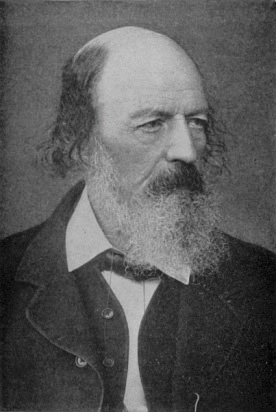
Alfred Tennyson was born into a middle class family in Lincolnshire, the son of a clergyman. Tennyson attended Trinity College, Cambridge where he published his first collection of poetry written with his two older brothers, both already students at Cambridge. The volume was called Poems by Two Brothers although all three collaborated on the work. Also while at Cambridge Tennyson became close friends with Arthur Henry Hallam. While visiting Tennyson’s family, Hallam met and later became engaged to one of Tennyson’s sisters. Before the marriage could take place, Hallam died. Tennyson’s devastation over Hallam’s death led him to write one of his greatest poems, the elegy In Memoriam A.H.H. The following verses from In Memoriam record a visit made to Trinity College after Tennyson’s student days; he describes walking through the campus to visit Hallam’s old rooms:
LXXXVII
‘I past beside the reverend walls
In which of old I wore the gown;
I roved at random through the town,
And saw the tumult of the halls;
And heard once more in College fanes
The storm their high-built organs make,
And thunder-music, rolling, shake
The prophet blazoned on the panes;
And caught once more the distant shout,
The measured pulse of racing oars
Among the willows; paced the shores
And many a bridge, and all about
The same gray flats again, and felt
The same, but not the same; and last
Up that long walk of limes I past
To see the rooms in which he dwelt.’
After his father’s death, Tennyson left Cambridge before graduating to assist his family. His 1833 volume of poems, which included “The Lady of Shalott,” received poor reviews. Discouraged by the criticism, he didn’t publish another volume until 1842. That volume, including “Ulysses,” was extremely popular with the public and was quickly followed by his long poems The Princess and In Memoriam A.H.H. When the Poet Laureate William Wordsworth died in 1850, Tennyson’s popularity led to his being appointed to the post. In addition, Queen Victorian, who admired Tennyson’s poetry, offered him a title and estate.
Tennyson, now Lord Tennyson, moved to his Farringford estate on the Isle of Wight, off the southern coast of England.
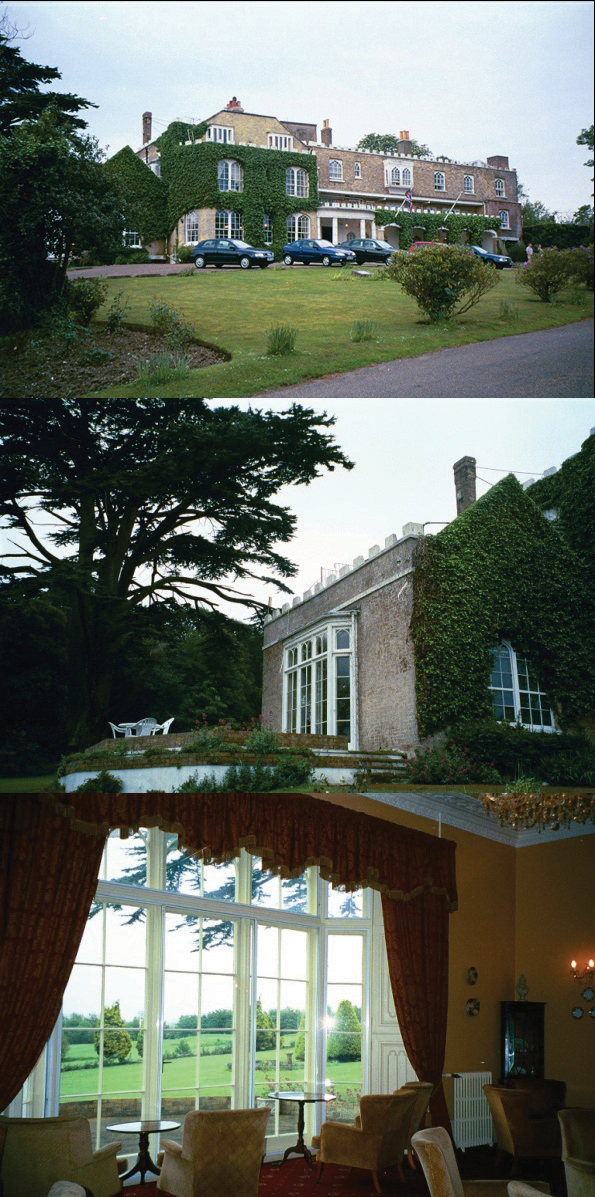
Farringford, Lord Tennyson’s home on the Isle of Wight.
While living at Farringford, Tennyson, a favorite of Queen Victoria, visited her at her Isle of Wight home, Osborne House. Tennyson took long rambling walks over the downs of the Isle of Wight, an area now known as Tennyson Down.
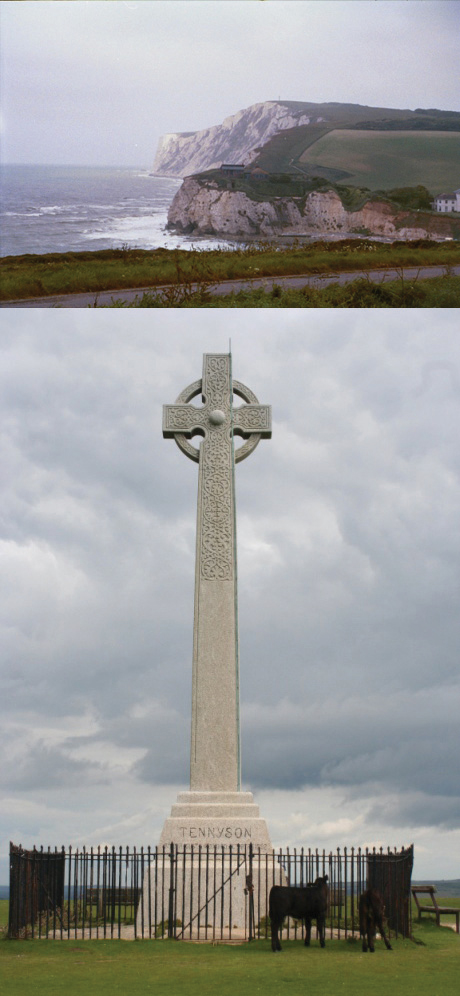
Tennyson Monument on Tennyson Down, Isle of Wight.
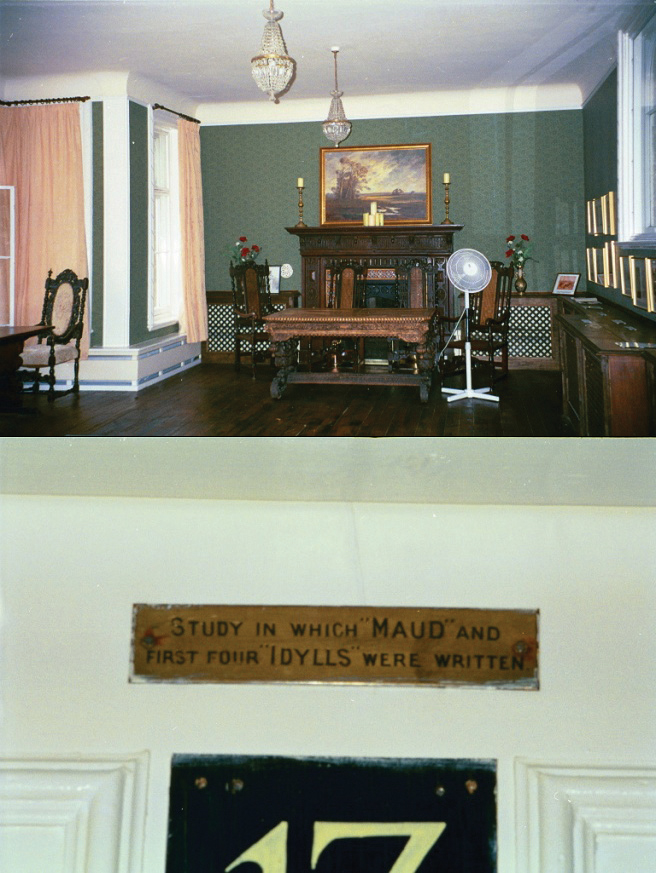
Tennyson’s study at Farringford.
When Tennyson died at age 83, he was buried in Westminster Abbey’s Poets Corner, next to Robert Browning.
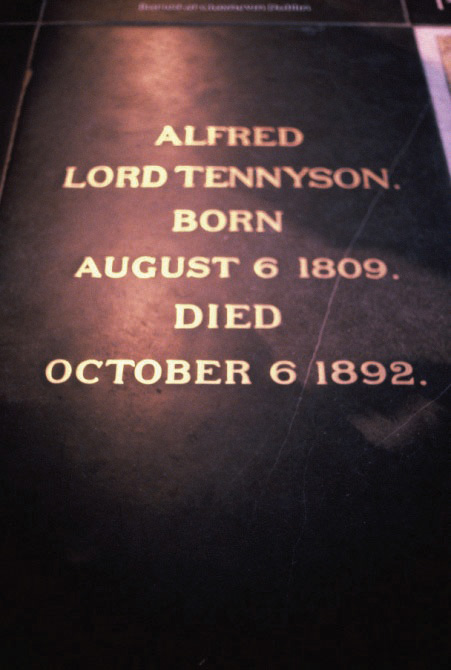
Texts
- “Crossing the Bar.” rpt. from English Poetry III: From Tennyson to Whitman. The Harvard Classics. 1909–14. Bartleby.com.
- “Crossing the Bar.” The Victorian Web. Dr. George Landow, Brown University.
- Idylls of the King. A Penn State Electronic Classics Series Publication. Jim Manis, Faculty Editor.
- Idylls of the King. The Project Gutenberg EBook of Idylls of the King, by Alfred, Lord Tennyson
- In Memoriam. Ed. W. J. Rolfe. Boston: Houghton Mifflin Co., 1895. University of Toronto, Robarts Library. Internet Archives.
- In Memoriam. Boston: Ticknor and Fields, 1865. Hathi Trust Digital Library.
- “The Lady of Shalott.” The Camelot Project at The Rochester University. comparison of 1833 and 1842 versions.
- “The Lady of Shalott.” The Victorian Web. Dr. George Landow, Brown University.
- “Ulysses.” rpt. from Edmund Clarence Stedman, ed. A Victorian Anthology, 1837–1895. Bartleby.com.
- “Ulysses.” The Victorian Web. Dr. George Landow, Brown University.
In Memoriam
Published at mid-century, 1850, the poem’s publication date symbolizes its philosophy, half-way between the mysticism of Coleridge’s “Eolian Harp” and Hardy’s “strings of a broken lyre.” In contrast with the Romantic view of nature as a spiritual or intellectual force, In Memoriam’s first six sections picture nature as an indifferent force and then, in section 130, the speaker recognizes Hallam’s essence in nature.
Tracing the speaker’s journey through grief, from despair to doubt and eventually to a reaffirmation of faith, In Memoriam embodies the Victorian conflict of faith and doubt. Rather than a stabilizing, constant force, faith appears to crumble in the midst of personal and social disorder.
In the Prologue, the speaker affirms faith in God in the famous first stanza:
Strong Son of God, immortal Love,
Whom we, that have not seen thy face,
By faith , and faith alone, embrace,
Believing where we cannot prove.
In stanza 5 of the Prologue, the speaker acknowledges that “our little systems”—which may refer to organized religion, to social structures, to governments, to scientific theories, to any systems resulting from human endeavors to impose order and certainty on the world—eventually fail.
Our little systems have their day;
They have their day and cease to be:
They are but broken lights of thee,
And thou, O Lord, art more than they.
The structure and unity of the poem hinge on time, the three Christmas Eves described in the poem. Otherwise the progression of ideas seems to wander from despair to hope and faith and back to despondency, perhaps a realistic picture of a journey through personal grief.
In Memoriam consists of 131 sections plus a prologue and an epilogue, all of varying numbers of stanzas composed of 4 lines of iambic tetrameter rhyming ABBA.
“The Lady of Shalott”
In “The Lady of Shalott,” Tennyson draws on the Arthurian legends, the stories of King Arthur and his knights of the Round Table, which he also uses in his major work, Idylls of the King.
While writing about the mythical medieval world of Camelot, Tennyson poses questions about his Victorian world: were Victorians, especially the upper classes, becoming complacent and self-satisfied; what is the relationship of the artist and the world?
The Lady of Shalott lives shut away in a tower on an island near Camelot. Note the description of her island in stanzas 1 and 2. Words such as “lilies” (which usually are white), “willows whiten,” “aspens” (which have whitish bark), “gray walls,” “gray towers,” and “silent” all add up to a picture of a drab, colorless world inhabited by the Lady.
Part 2 informs us that the Lady of Shalott spends her life weaving in her tower. Because of a curse that has been put on her, she cannot even look out the window, certainly not go outside the tower into the world. She can see the world only through her weaver’s mirror which reflects the events going on outside her window. Tennyson does not give us any information about the “curse”; we don’t know who cursed the Lady or why. Apparently Tennyson considers these details unimportant; we accept the curse as a supernatural, fairy tale element. The focus, instead, is on the Lady’s reaction to her banishment from being involved in the world. Notice the last two lines of Part 2.
In Part 3, attention shifts to the world outside the tower as Sir Lancelot rides by. In contrast to the pale, colorless description of the Lady’s world, Sir Lancelot is described in bright, colorful terms: “dazzling,” “flamed,” “sparkled,” “glittered,” “golden,” “blazoned,” “jeweled,” “glowed,” “burnished,” “flashed.” The last stanza of Part 3 relates the Lady’s reaction to seeing Sir Lancelot in her mirror.
Part 4 concludes the story. As soon as the Lady looks out the window and directly at the world, the curse comes upon her. Her weaving, her art, flies out the window. She leaves her tower, climbs into a boat, and dies as the boat drifts toward Camelot. Ironically, Sir Lancelot voices a final blessing on the Lady of Shalott.
Many artists have painted their impressions of Tennyson’s poem. One of the most well-known is this painting by John William Waterhouse.

The Lady of Shalott, based on Tennyson’s poem.
Source: John William Waterhouse 1888.
Idylls of the King
At Farringford Tennyson finished one of his major works, the long poem Idylls of the King, a series of twelve narrative poems based on the Arthurian legends.
The first four Idylls, published in 1856, were “Enid,” “Vivien,” “Elaine,” and “Guinevere.” As suggested by the title Tennyson originally planned, The True and the False, these four idylls place four women characters on a spectrum of good and evil, fidelity and betrayal, idealism and reality. The rejection of The True and the False as a title in favor of The Idylls of the King shifts the focus to Arthur. Rather than standing individually, the four women in the completed work serve as pivotal points in a schema dominated by the king. Although revised and fitted into this more expansive plan, the four poems are still the cornerstones of The Idylls, their stories functioning as vehicles for the presentation of theme. The complexity of theme is reflected in the complexity of the characters’ dilemmas, and is played out, not among the four women or in an attempt to place them on a spectrum, but in each individual’s effort to deal with the real and the ideal. In each idyll, Arthur’s standards, his values, his vision are the controls which govern the action and the result.
In 1862, Tennyson dedicated the expanded work to the memory of Prince Albert, much to the pleasure of the widowed Queen Victoria. In the epilogue “To the Queen,” Tennyson describes his work as “shadowing Sense at war with Soul,” an expression of the faith and doubt conflict of the Victorian Age. In this war of Sense and Soul, Arthur’s stance is the touchstone and Enid, Vivien, Elaine, and Guinevere, the tokens of the battle.
The Idylls of the King may be read as Tennyson’s commentary on problems he recognized in Victorian society, including loss of religious faith, the dehumanizing effects of industrialization, complacency among the upper classes, and the active versus the inactive life.
“Ulysses”
For the dramatic monologue, “Ulysses,” Tennyson borrows a character from classical Greek literature, the Odyssey. Tennyson portrays the main character Ulysses (the Latin version of the Greek name Odysseus) after he has returned home from his 20-year voyage following the Trojan War.
Because this poem is a dramatic monologue, we can identify the four characteristics of that form. The fictional speaker of the poem is, of course, Ulysses. The dramatic moment is a moment of choice in his life: he has to decide whether to stay at home to rule his kingdom or to return to the sea for more adventures (see line 6). The silent but identifiable listeners are his mariners, the sailors whom he tries to convince to accompany him on one more great voyage (see lines 45–46). The entire poem provides a vivid picture of Ulysses as a man not content to sit at home but who wants to cram as much experience as possible into his life.
In the first stanza, Ulysses speaks disparagingly of his people, referring to them in animal terms (lines 4–5). He complains about the idleness of his life and how old his wife has become (apparently not realizing that she is also stuck with an old husband).
Stanza 2 proclaims Ulysses’s desire to live life to the fullest. In the well-known lines 22–26 he complains about the dullness of retiring from an active life and expresses his wish to live as fully as possible in the time remaining.
In stanza 3, Ulysses turns to his son Telemachus, expressing his intent to leave him in charge of ruling Ithaca. A question raised in these lines is if Ulysses thinks less of his son for staying at home instead of seeking new experiences like his father. Consider lines 39–40.
In stanza 4, Ulysses addresses his mariners, urging them to accompany him. He concedes that they are old, yet convinces them that even in old age “some work of noble note” may still be accomplished. See lines 49–57. The last line of the poem is a famous one that expresses Ulysses’s determination to keep trying, to keep accomplishing, rather than to be satisfied with past accomplishments.
Both of these poems, “The Lady of Shalott” and “Ulysses,” employ a common theme in Tennyson’s work: the active life versus the inactive life. Both poems portray characters who make a decision to become actively involved in life when they might more safely sit on the sidelines. Tennyson includes in these works a message for his Victorian society; he fears that they, too, may become complacent. In a century pleased with its expansive empire, its technological and industrial progress, and its scientific advances, Tennyson reminds readers that there are always new horizons to explore.
“Crossing the Bar”
Tennyson stated that he composed “Crossing the Bar” while sailing from the Isle of Wight to the mainland at Lymington. Composed in 1889, the poem is often considered an elegy for Tennyson himself. Before his death in 1892, Tennyson requested that “Crossing the Bar” be placed last in every collection of his poetry.

View from a ferry crossing the Isle of Wight to Lymington.
Crossing the Bar
Sunset and evening star,
And one clear call for me!
And may there be no moaning of the bar,
When I put out to sea,
But such a tide as moving seems asleep,
Too full for sound and foam,
When that which drew from out the boundless deep
Turns again home.
Twilight and evening bell,
And after that the dark!
And may there be no sadness of farewell,
When I embark;
For though from out our bourne of Time and Place
The flood may bear me far,
I hope to see my Pilot face to face
When I have crossed the bar.
Key Takeaways
- Tennyson’s In Memoriam may be read as a personal working through grief and as an expression of Victorian conflict leading toward a modern view of nature and social order.
- Tennyson’s Arthurian works also reflect conflicts evident in Victorian thought.
Exercises
-
Compare Tennyson’s lines from In Memorian with Shelley’s lines from another of the great elegies, Adonais:
Our little systems have their day;
They have their day and cease to be:
They are but broken lights of thee,
And thou, O Lord, art more than they.
Tennyson
The One remains, the many change and pass;
Heaven’s light forever shines, Earth’s shadows fly;
Life, like a dome of many-coloured glass,
Stains the white radiance of Eternity,
Until Death tramples it to fragments.
Shelley
- Although published before On the Origin of Species (1859), the quotation “Nature red in tooth and claw” (In Memoriam, section 56) is often cited as characterizing Darwin’s idea of natural selection. Trace references to nature throughout the poem and identify those that suggest a naturalist view, (literature that posits an indifferent natural universe working according to scientific law and that sees human action as the result of natural processes and the environment) and those that suggest a more Romantic view.
- Critics have interpreted the Lady of Shalott as depicting the dilemma of artists with a choice of living in the world or alienating themselves from the world to devote themselves to their art. Evaluate “The Lady of Shalott” as a statement of an artist’s relationship to society.
- Why did the Lady of Shalott look out her window even though she knew a curse would come upon her?
- In your opinion, did the Lady of Shalott do the right thing in looking out the window?
- What is your opinion of Ulysses? Do you admire his desire to keep striving to achieve more in his life, or do you think he was abandoning his responsibilities to his kingdom?
-
“Ulysses” is a dramatic monologue. Analyze the poem as a dramatic monologue by identifying the four characteristics of dramatic monologues:
- a fictional speaker
- a speech made at a dramatic moment in the speaker’s life
- a silent but identifiable listener
- a revelation of the speaker’s character
- What is the overriding metaphor of “Crossing the Bar”? Identify the various specifics of the nautical metaphor.
Resources
General Information
- “Alfred Tennyson.” Dr. John P. Farrell, University of Texas. Studies of Victorian Literature. images, texts, and critiques.
- Alfred Tennyson. The Victorian Web. Dr. George Landow, Brown University.
Biography
- “Alfred, Lord Tennyson.” Cambridge Authors. Cambridge University.
- “Alfred Lord Tennyson: A Brief Biography.” The Victorian Web. Prof. Glenn Everett, University of Tennessee at Martin.
- “Alfred Lord Tennyson Chronology.” The Victorian Web. Prof. Glenn Everett, University of Tennessee at Martin.
- “Lord Alfred Tennyson.” Academy of American Poets. Poets.org.
Texts
- “Crossing the Bar.” rpt. from English Poetry III: From Tennyson to Whitman. The Harvard Classics. 1909–14. Bartleby.com.
- “Crossing the Bar.” The Victorian Web. Dr. George Landow, Brown University.
- Idylls of the King. A Penn State Electronic Classics Series Publication. Jim Manis, Faculty Editor.
- Idylls of the King. The Project Gutenberg EBook of Idylls of the King, by Alfred, Lord Tennyson
- In Memoriam. Ed. W. J. Rolfe. Boston: Houghton Mifflin Co., 1895. University of Toronto, Robarts Library. Internet Archives.
- In Memoriam. Boston: Ticknor and Fields, 1865. Hathi Trust Digital Library.
- “The Lady of Shalott.” The Camelot Project at The Rochester University. comparison of 1833 and 1842 versions.
- “The Lady of Shalott.” The Victorian Web. Dr. George Landow, Brown University.
- “Ulysses.” rpt. from Edmund Clarence Stedman, ed. A Victorian Anthology, 1837–1895. Bartleby.com.
- “Ulysses.” The Victorian Web. Dr. George Landow, Brown University.
Audio
- “The Charge of the Light Brigade.” Wax cylinder recording of Tennyson reading part of his poem.
- “Crossing the Bar.” LibriVox.
- “The Lady of Shalott.” LibriVox.
- “Reading Tennyson: 23 October 2009.” A Celebration of the Bicentenary of the Birth of Alfred, Lord Tennyson. Faculty of English. Cambridge University.
- “Ulysses.” LibriVox.
Images
- “Pictorial Interpretations of Tennyson’s ‘The Lady of Shalott.’” The Victorian Web. Dr. George Landow, Brown University.
Video
- “Alfred Tennyson—Proms Literary Festival.” BBC Radio 3 Video. YouTube.
Podcast
- “Tennyson’s In Memoriam.” In Our Time. BBC Radio 4.
7.7 Matthew Arnold (1822–1888)
PLEASE NOTE: This book is currently in draft form; material is not final.
Learning Objectives
- Characterize “Dover Beach” as a dramatic monologue.
- Relate “Dover Beach” to the Victorian conflict of faith and doubt.
- Evaluate the role of nature in “Dover Beach.”
Biography
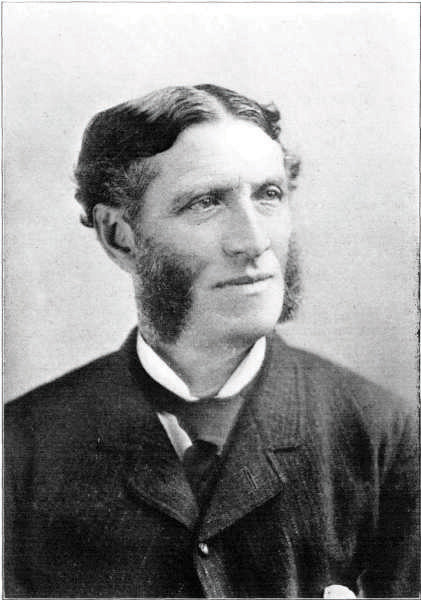
From a family of educators, Matthew Arnold was well educated and widely read even before he won a scholarship to Balliol College, Oxford University. For a time, his family lived in the Lake District, where Arnold met William Wordsworth. Arnold worked as a teacher, a fellow at Oriel College Oxford, a school inspector, and finally Professor of Poetry at Oxford. His poetry includes Thyrsis, an elegy to his friend Arthur Clough, considered along with Milton’s Lycidas, Shelley’s Adonais, and Tennyson’s In Memoriam to be the great pastoral elegies of British literature. Other of Arnold’s major poems include “The Scholar Gipsy,” “Tristram and Iseult,” and “Sohrab and Rustum.”
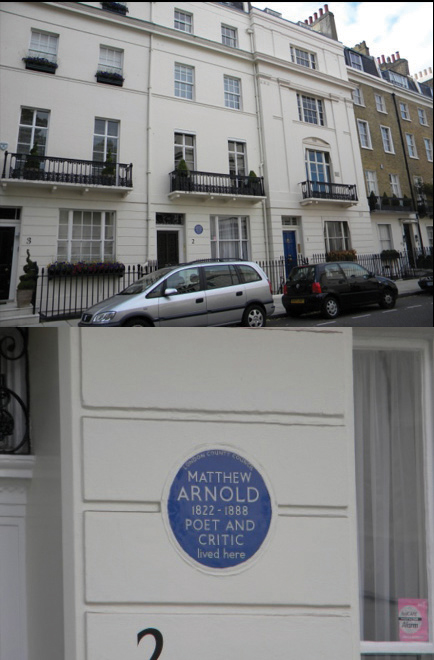
In addition to his poetry, Arnold wrote prose works addressing literature (Essays in Criticism), cultural and class issues (Culture and Anarchy) and religious issues (Literature and Dogma) in Victorian England. Throughout much of the 20th century, the reputation of Arnold’s prose works overshadowed that of his poetry.
Text
- “Dover Beach.” rpt. in Edmund Clarence Stedman. ed. A Victorian Anthology, 1837–1895. Bartleby.com.
- “Dover Beach.” The Victorian Web. Dr. George Landow, Brown University.
“Dover Beach”
The sea is calm to-night.
The tide is full, the moon lies fair
Upon the straits; on the French coast the light
Gleams and is gone; the cliffs of England stand;
Glimmering and vast, out in the tranquil bay.
Come to the window, sweet is the night-air!
Only, from the long line of spray
Where the sea meets the moon-blanched land,
Listen! you hear the grating roar
Of pebbles which the waves draw back, and fling,
At their return, up the high strand,
Begin, and cease, and then again begin,
With tremulous cadence slow, and bring
The eternal note of sadness in.
Sophocles long ago
Heard it on the Aegean, and it brought
Into his mind the turbid ebb and flow
Of human misery; we
Find also in the sound a thought,
Hearing it by this distant northern sea.
The Sea of Faith
Was once, too, at the full, and round earth’s shore
Lay like the folds of a bright girdle furled.
But now I only hear
Its melancholy, long, withdrawing roar,
Retreating, to the breath
Of the night-wind, down the vast edges drear
And naked shingles of the world.
Ah, love, let us be true
To one another! for the world, which seems
To lie before us like a land of dreams,
So various, so beautiful, so new,
Hath really neither joy, nor love, nor light,
Nor certitude, nor peace, nor help for pain;
And we are here as on a darkling plain
Swept with confused alarms of struggle and flight,
Where ignorant armies clash by night.
Video Clip 4
Matthew Arnold’s “Dover Beach”
(click to see video)View a video mini-lecture on Matthew Arnold’s “Dover Beach.”
Key Takeaways
- Arnold’s “Dover Beach” is an example of a dramatic monologue.
- “Dover Beach” addresses the Victorian conflict of faith and doubt.
Exercises
- Matthew Arnold’s “Dover Beach” uses a pattern familiar in the Romantic poetry of the earlier 19th century, an observation of nature which leads to a meditation. Describe the natural phenomenon that Arnold sees and hears in lines 1 through 14.
- Lines 15 through 20 serve as a transition into the meditation. Of what do the sights and sounds of nature make him think?
- Lines 21 through 28 contain the meditation, including Arnold’s famous metaphor of the “sea of faith.” What is the “sea of faith” and what is happening to it?
- How does Arnold describe the world in lines 29 through 37? What metaphor does he use to picture the state of the world?
-
“Dover Beach” is a dramatic monologue. Analyze the poem as a dramatic monologue by identifying the four characteristics of dramatic monologues:
- a fictional speaker
- a speech made at a dramatic moment in the speaker’s life
- a silent but identifiable listener
- a revelation of the speaker’s character
Resources
Biography
- “Matthew Arnold.” Academy of American Poets. Poets.org.
- “Matthew Arnold: A Biography.” rpt. from British Authors of the Nineteenth Century. Ed. Stanley Kunitz. New York: H.W. Wilson, 1936. 16–18. The Victorian Web.
- “Matthew Arnold: A Chronology.” The Victorian Web. Dr. George Landow, Brown University.
Text
- “Dover Beach.” rpt. in Edmund Clarence Stedman. ed. A Victorian Anthology, 1837–1895. Bartleby.com.
- “Dover Beach.” The Victorian Web. Dr. George Landow, Brown University.
Audio
- “Dover Beach.” LibriVox.
Video
- “Matthew Arnold’s Dover Beach.” Dr. Carol A. Lowe, McLennan Community College.
7.8 Oscar Wilde (1854–1900)
PLEASE NOTE: This book is currently in draft form; material is not final.
Learning Objectives
- Define comedy of manners and apply the definition to The Importance of Being Earnest.
- Analyze the use of characteristics of comedy of manners in The Importance of Being Earnest.
- Appraise The Importance of Being Earnest as a criticism of and satire on Wilde’s contemporary society.
Biography
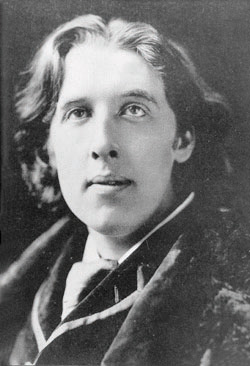
Oscar Wilde was born in Dublin, Ireland, moved to England to attend Oxford University, and then moved to London. Wilde had been rejected by his first love, but in London met and married Constance Lloyd, with whom he had two children.
Wilde is considered one of the founders of the aesthetic movementThe theory of “art for art’s sake” that places the pursuit of beauty as the highest purpose of art., the theory of “art for art’s sake” that places the pursuit of beauty as the highest purpose of art. Aestheticism, with its ideals of beauty and the belief that art and morality are not connected, spread throughout Europe in the late 19th century. The aesthetic philosophy contrasted with the Victorian ideals of duty, decorum, and decency represented by Queen Victoria and perceived in the works of Victorian writers such as Browning and Tennyson. In addition to literature, aestheticism influenced visual and decorative arts. From aestheticism grew the concept of the alienated artist, divorced from mainstream society, isolated from a middle class who cannot understand his/her work, an individual of more sensitive perception, more refined sensibilities than the ordinary person.
Wilde wrote children’s books, the novel The Picture of Dorian Gray, and, most famously, a series of satirical plays, the last and most well known The Importance of Being Earnest.
In the 1890s, Wilde’s scandalous court trials all but overshadowed his literary accomplishments. When the Marquis of Queensberry accused Wilde of homosexuality, Wilde sued him for libel. During the trial, witnesses testified that Wilde was guilty of homosexual activity, and even though Wilde dropped his suit against the Marquis, the government issued a warrant for Wilde’s arrest on charges of homosexual activity. Found guilty and sentenced to two years in prison, Wilde suffered declining health throughout his imprisonment. After his release, he moved to France and died there in 1900.
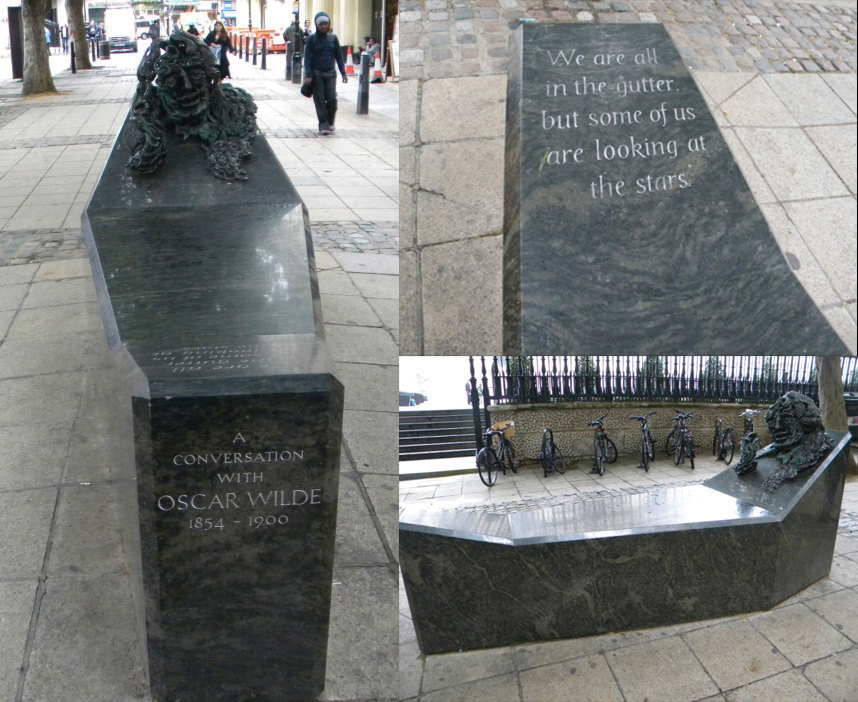
A contemporary bench commemorating Oscar Wilde near St. Martin’s in the Field, London.
Text
- The Importance of Being Earnest. CELT: Corpus of Electronic Texts. University College Cork, Ireland.
- The Importance of Being Earnest. Project Gutenberg.
- The Importance of Being Earnest: A Trivial Comedy for Serious People. London: Methuen & Co., 1919. Hathi Trust Digital Library.
Comedy of Manners
First produced in 1895, Wilde’s play The Importance of Being Earnest abounds in witticisms and sly criticism of late Victorian society.
The Importance of Being Earnest is a comedy of manners, a type of play popularized in the late 17th and 18th centuries. A comedy of mannersA witty, satirical play which mocks aristocratic society. is a witty, satirical play which mocks aristocratic society. Wilde revived the comedy of manners, which had its zenith in the Restoration comedies of Sheridan and Goldsmith, to write an immensely popular, funny criticism of Victorian aristocracy. In the play, Wilde attacks Victorian complacency, as did Tennyson, but in a very different manner. Wilde displays the foibles of society for ridicule and for his audience’s amusement.
Albert Edward, the future King Edward VII, was the eldest son of Queen Victoria and Prince Albert. Although he was heir to the throne, his mother did not entrust him with royal duties or make any attempts to prepare him for his future role as king. Instead, the Prince of Wales (known as Bertie to his family and friends) became the most prominent member of a group of highly elite socialites, the Marlborough House Set, named for the house Albert Edward occupied with his wife and family. Even after he married Princess Alexandra of Denmark (an arranged marriage), Bertie was notorious for his extravagant lifestyle and his string of mistresses, ranging from actresses to the wives of other noblemen, one of whom was at his bedside when he died. He fathered a number of illegitimate children, some of them passed off as the children of their mothers’ husbands.
Bertie’s crowd of affluent individuals did not work for a living (their families being independently wealthy), spent their lives in pursuit of pleasure, and gathered at their country estates for long weekends of hunting, card playing, and flirting. All members of this group would, like Wilde’s character Jack, have homes in the city and in the country.
One of Bertie’s well-known mistresses was Daisy, Countess of Warwick, wife of Francis Greville, Lord Brooke, the Earl of Warwick. Daisy and her husband lived in Warwick Castle, the medieval castle that had for generations been home to the Earls of Warwick. Daisy was one of the most popular hostesses of country weekends at the magnificent Warwick Castle. Warwick was owned by the same family until 1978 but is now open as a tourist attraction. One of the exhibits at Warwick Castle is called “A Royal Weekend Party” and depicts Albert Edward (Bertie) the Prince of Wales, Daisy Countess of Warwick, and others of the Marlborough House Set.
In The Importance of Being Earnest, Wilde writes satirically about these people, the aristocracy of late Victorian England.
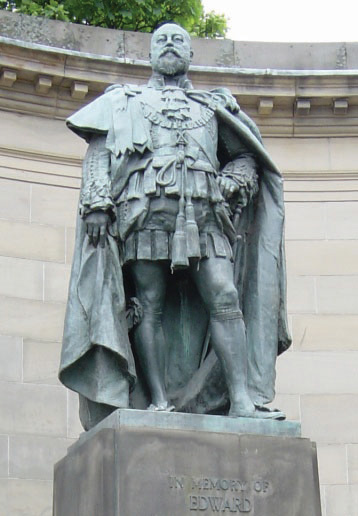
A statue of Edward VII at Holy Rood Palace in Edinburgh, Scotland.

Warwick castle.
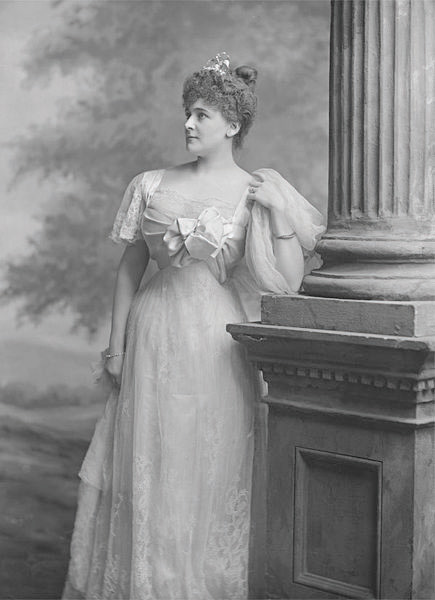
Daisy, Countess of Warwick.

Characteristics of Comedy of Manners
- Realistic. In The Importance of Being Earnest, Wilde presents aristocratic characters, members of highest Victorian society, people such as the Prince of Wales and his circle. While Jack, Algernon, Lady Bracknell, and Gwendolen may be exaggerated, the Victorians would have recognized their similarity to a real group of people.
- Satiric.SatireA literary manner, used in any genre (in this case in drama), that blends criticism of a person, event, or situation with witty humor for the purpose of improving the object of the satire. is a literary manner, used in any genre (in this case in drama), that blends criticism of a person, event, or situation with witty humor for the purpose of improving the object of the satire. Satire is mocking but always with a serious underlying purpose; the goal is to use humor to make the audience aware of a situation that needs improvement. In this case, Wilde satirizes the British aristocracy. He also makes fun of numerous facets of Victorian life—note the comments on everything from the British education system to marriage to Darwinism (Darwin’s theories suggest that humans, like animals, behave according to instinct; Cecily comments twice on her “instinctive” knowledge).
- Focus on a dissipated and superficial society. The primary target of satire is the twisted values of the characters. The title of the play is, in itself, a pun on the word “earnest,” meaning honest. The characters are anything but earnest. They value appearance above all else. Note Lady Bracknell’s criteria for a potential husband for her daughter. The young ladies themselves have only one criterion for a future husband: his name must be Ernest. It doesn’t matter if he is a man of character, honesty, worthiness; he just has to have the right name. If any word characterizes Queen Victoria and her age, it is the word earnest; Wilde divulges the insincerity underlying much apparent Victorian earnestness.
- Use of stock characters. Stock characters are stereotypes that appear in all comedies of manners. All comedies of manners will have an ingénue (Cecily in this play); they all will have a dandy (a young man concerned with fashion and fun—Jack and Algernon), they will have an authoritative matron (Lady Bracknell in this case).
- Dominance of dialogue over plot. There is little action; the dialogue is the important element of the play.
- Presence of intrigue in plot. In a comedy of manners there is a mystery to solve: in this play, Jack’s identity.
- Amoral characters. As might be expected within the aesthetic movement, characters display a distinct lack of perception of moral values. Algernon, for instance, lies as easily about cucumber sandwiches as about his financial situation or his potential fiancée. Equally, he expects his servant to lie for him (a jab at the Victorian idea that the upper classes had a duty to set a moral example for those of lower classes). He creates an elaborate fiction (Bunbury) to use as an excuse for anything he doesn’t want to do. Even Jack comments that the truth is not the sort of thing one tells a nice, young girl.
Key Takeaways
- The Importance of Being Earnest is a comedy of manners that exemplifies key characteristics of the form.
- Victorian audiences recognized the satire of the aristocracy and of Victorian “earnestness” in the play.
Exercises
- Consider the title of the play. What is the meaning of the title? Why is the title ironic? To whom does the title apply?
- Make a list of the objects of satire in this play. For example, Victorian education is satirized when Lady Bracknell comments, “Fortunately in England at any rate education produces no effect whatsoever.”
- What is Bunburying? What is its purpose?
- Of the two young ladies Cecily and Gwendolen, does either seem more sincere, more “earnest” than the other? In what ways are they different? In what ways are they the same?
- How does the play represent the relationship between the classes in Victorian society? Do you think this portrayal is realistic?
-
How is marriage depicted? Although not as prevalent or as overt as in the Middle Ages, marriages were, in a sense, still arranged among the upper classes in Victorian England. Albert Edward, the Prince of Wales, for example, had to marry an appropriate young woman from European royalty even though the two didn’t know each other. Aristocratic young people in Victorian England usually married for the sake of family connection, maintenance of wealth, and the unifying of estates or businesses although those involved had the appearance of making their own choices. Even in the mid-20th century, the late Princess Margaret, younger sister of the current Queen Elizabeth II, was unable to marry the man with whom she fell in love because he was divorced and therefore deemed unsuitable. Although Princess Margaret ostensibly made her own decision not to marry him, she was pressured by her sister the Queen and the government to make a more appropriate choice of husband. Even in the 1980s, Lady Diana Spenser married Charles, Prince of Wales after meeting him only 13 times and was considered an appropriate choice of bride because of her family’s lineage and her own innocent past.
How does society’s expectation of “appropriate” marriages influence the treatment of marriage in the play?
- What role do diaries, notes, letters, manuscripts play in the plot? How does written communication compare with spoken communication?
- By the end of the play, who, if anyone, deserves the name Ernest?
- The play is subtitled “A Trivial Comedy for Serious People.” What is the significance of the subtitle?
Resources
General Information
- “The Important of Being Earnest”: The First Stage Production, 1895. Victoria and Albert Museum.
- “A Reader’s Guide to The Importance of Being Earnest.” Dr. Stephanie Forward. The Open University, UK.
- “Oscar Wilde.” The Victorian Web. George P. Landow, Brown University..
- The Oscar Wilde Society. includes a biography and images of historic play programs.
- Reading Wilde: Querying Spaces: An Exhibition Commemorating the 100th Anniversary of the Trials of Oscar Wilde. New York University Libraries.
- “The Trials of Oscar Wilde 1895.” Famous World Trials. Prof. Douglas O. Linder. University of Missouri-Kansas City School of Law.
Biography
- “Chronology of Oscar Wilde.” CELT: Corpus of Electronic Texts. University College Cork, Ireland.
- “Oscar Fingal O’Flaherty Wilde (1854–1900).” The Victorian Web. Philip V. Allingham, Lakehead University.
- “Oscar Wilde Chronology.” The Victorian Web. George P. Landow, Brown University..
- “Oscar Wilde.” Literary San Antonio. English Department, San Antonio College. information on Wilde’s speech in San Antonio, Texas.
- “Oscar Wilde: The Spectacle of Criticism.” Dr. Sandra F. Siegel, Cornell University. Arts & Sciences Newsletter. Spring 1996: 17.2. argues that the flamboyant image of Wilde has overshadowed the more realistic view of the writer.
Text
- “The Importance of Being Earnest.” CELT: Corpus of Electronic Texts. University College Cork, Ireland.
- “The Importance of Being Earnest.” Project Gutenberg.
- “The Importance of Being Earnest: A Trivial Comedy for Serious People.” London: Methuen & Co., 1919. Hathi Trust Digital Library.
Audio
- “The Importance of Being Earnest.” Project Gutenberg.
- “The Importance of Being Earnest.” LibriVox.
Concordance
- ISU Play Concordances: The Importance of Being Earnest. Rosanne G. Potter and Joe Struss. Iowa State University.
Images
- “Oscar Wilde.” Great Britons: Images from the National Portrait Gallery, London.
- “Photographs of Oscar Wilde and His Circle at the Clark Library.” William Andrews Clark Memorial Library. University of California Los Angeles.




